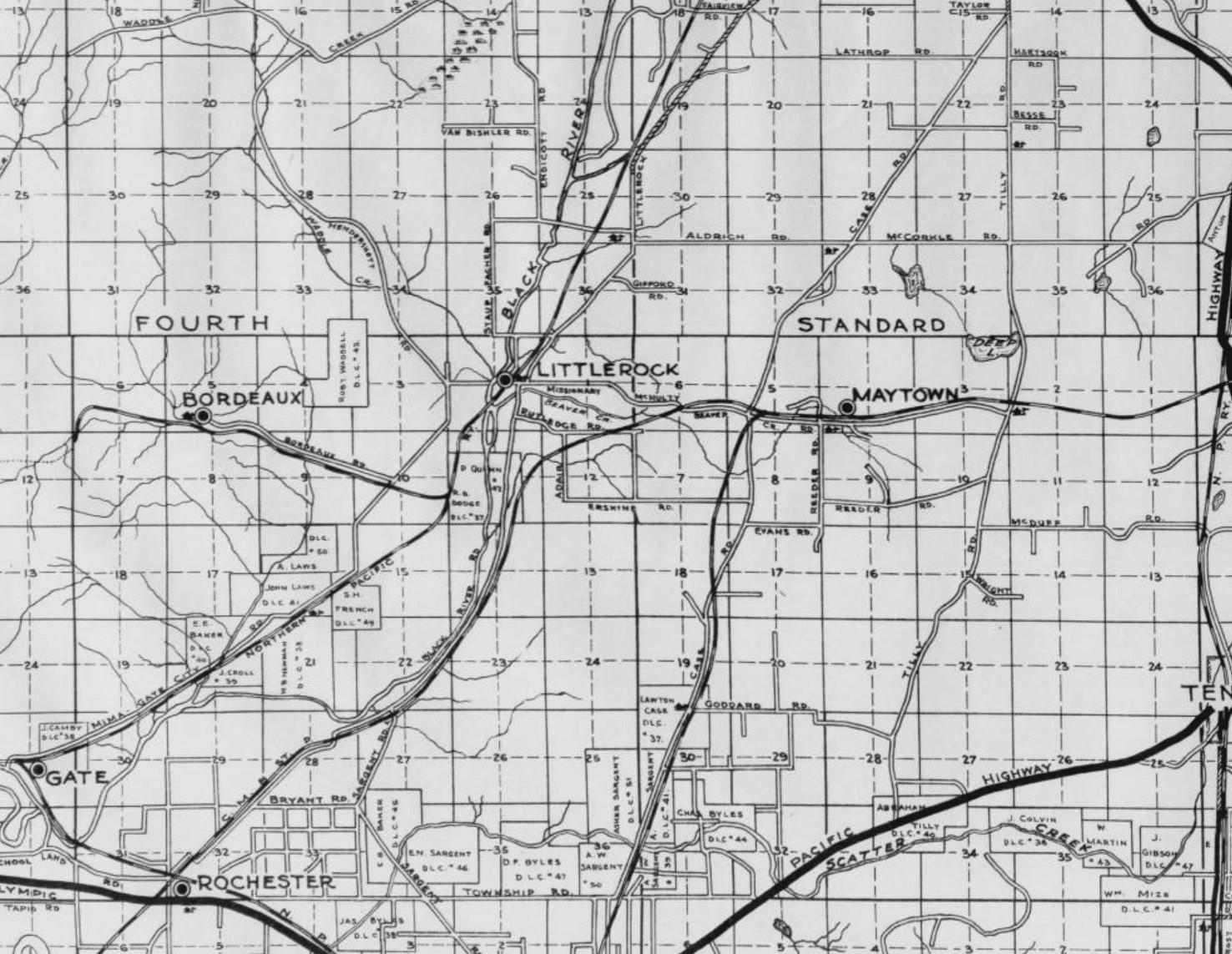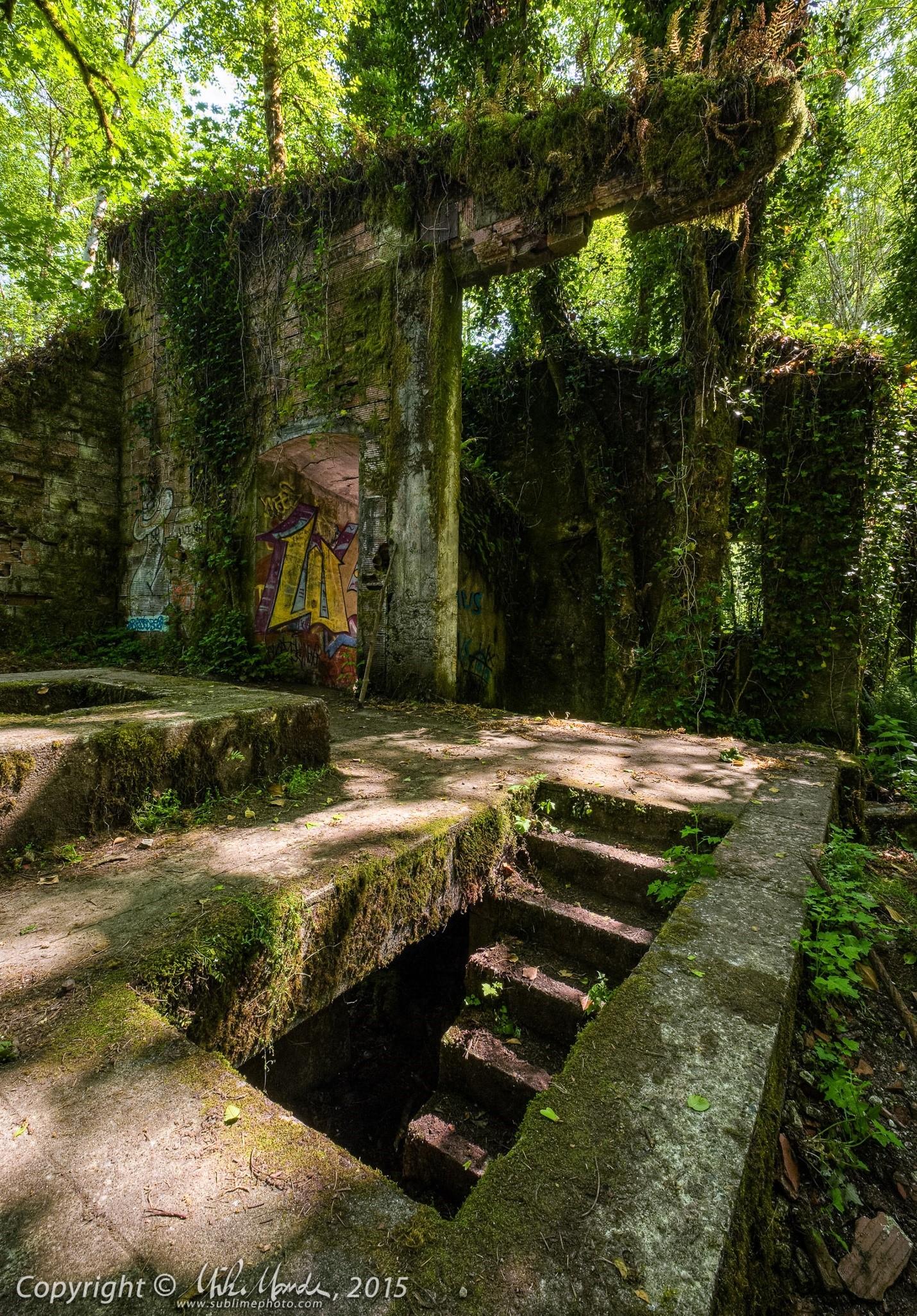Number 18
August 2022
Margaret Whyte: Advocate for Senior Living

Luther J. Wyckoff: The Frolicsome Heifer of Oz
Making Moss Surgical Dressings: A Forgotten Part of the Thurston County Homefront During World War I



Number 18
August 2022
Margaret Whyte: Advocate for Senior Living

Luther J. Wyckoff: The Frolicsome Heifer of Oz
Making Moss Surgical Dressings: A Forgotten Part of the Thurston County Homefront During World War I


The Thurston County Historical Journal is dedicated to recording and celebrating the history of Thurston County.
The Journal is published by the Olympia Tumwater Foundation as a joint enterprise with the following entities: City of Lacey, City of Olympia, Confederated Tribes of the Chehalis Reservation, Daughters of the American Revolution, Daughters of the Pioneers of Washington/Olympia Chapter, Lacey Historical Society, Old Brewhouse Foundation, Olympia Historical Society and Bigelow House Museum, South Thurston County Historical Society, Thurston County, Tumwater Historical Association, Yelm Prairie Historical Society, and individual donors.
Publisher
Olympia Tumwater Foundation
John Freedman, Executive Director
Lee Wojnar, President, Board of Trustees
110 Deschutes Parkway SW P.O. Box 4098 Tumwater, Washington 98501 360-943-2550
www.olytumfoundation.org
Editor Karen L. Johnson 360-890-2299
karen@olytumfoundation.org
Editorial Committee
Drew W. Crooks Jennifer Crooks
James S. Hannum Erin Quinn Valcho
The Journal does not offer a subscription service. To get your own copy, join one of the heritage groups listed at the top of this page. These groups donate to the publication of the Journal, and thus receive copies to pass on to their members. Issues are also available for purchase at the Bigelow House Museum, Crosby House Museum, and Lacey Museum, and occasionally at Orca Books in downtown Olympia and Hedden’s Pharmacy in Tenino.
One year after print publication, digital copies are available at www.ci.lacey.wa.us/TCHJ.
The Journal welcomes factual articles dealing with any aspect of Thurston County history. Please contact the editor before submitting an article to determine its suitability for publication. Articles on previously unexplored topics, new interpretations of well-known topics, and personal recollections are preferred. Articles may range in length from 100 words to 10,000 words, and should include source notes and suggested illustrations.
Submitted articles will be reviewed by the editorial committee and, if chosen for publication, will be fact-checked and may be edited for length and content. The Journal regrets that authors cannot be monetarily compensated, but they will gain the gratitude of readers and the historical community for their contributions to and appreciation of local history.
Opinions expressed by contributors are not necessarily those of the Olympia Tumwater Foundation.
Written permission is required to reproduce any part of this publication.
Copyright © 2022 by the Olympia Tumwater Foundation. All rights reserved.
ISSN 2474-8048
Number 18
August 2022
3 Margaret Whyte: Advocate for Senior Living Deborah Jane Ross
18 Luther J. Wyckoff: The Frolicsome Heifer of Oz David Maxine
23 Making Moss Surgical Dressings: A Forgotten Part of the Thurston County Homefront During World War I Drew W. Crooks
32 A Song for Washington Karen L. Johnson
Back Cover
Who/What/Where Is It?
On the cover: Sphagnum (or peat) moss proved useful for surgical dressings during World War I. Photograph courtesy of Capitol Land Trust.
The Temple of Justice in Olympia, seen in this 1916 photograph, was one place in Thurston County where moss surgical dressings were made by Red Cross volunteers during World War I. Photograph courtesy of Washington State Archives, General Subjects Photograph Collection, 1845-2005.
See related article on page 23.

Near the auditorium of the Panorama retirement community in Lacey, Washington, a half-hidden boulder abuts a small garden. A plaque mounted on the boulder reads:
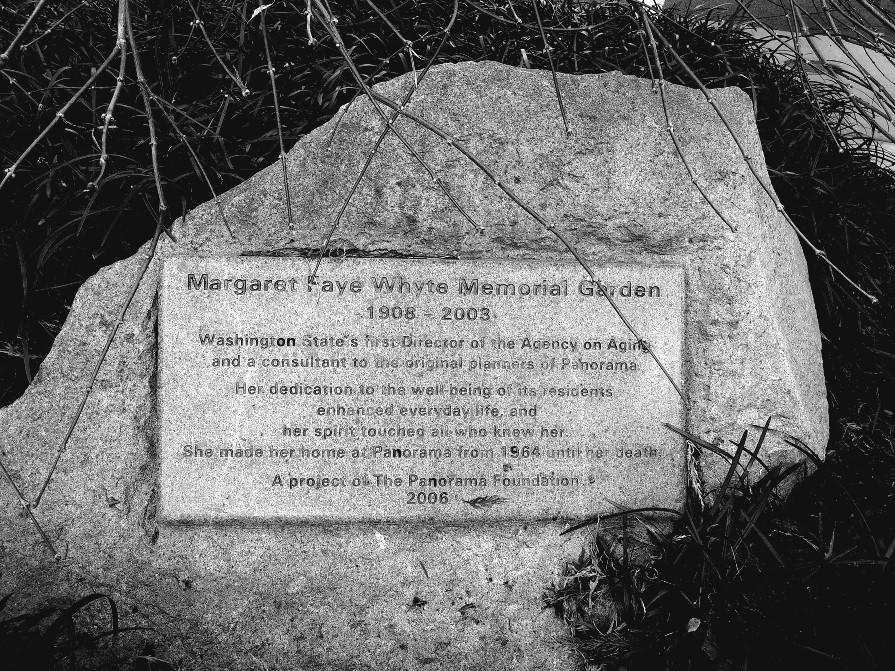
“Margaret Faye Whyte Memorial Garden 1908-2003. Washington State’s first Director of the Agency on Aging and a consultant to the original planners of Panorama. Her dedication to the well-being of its residents enhanced everyday life, and her spirit touched all who knew her. She made her home at Panorama from 1964 until her death. A project of The Panorama Foundation 2006”
The memorial garden and its plaque are fitting tributes to a woman who was instrumental in establishing Panorama as the first Continuing Care Retirement Community in the Pacific Northwest. Whyte also improved the lives of thousands of other Washington State residents with her advocacy of the notion that seniors can live full and active lives, and continue to make meaningful contributions to their communities. Though many of the innovations that she introduced to our area are taken for granted now, her name has nearly been forgotten.
Margaret Whyte was born on July 2, 1908 in Goldfield, Iowa, to Ethel Gertrude Conger Whyte and George Henry Whyte. George was a garage owner and later a Ford dealer, Ethel was a homemaker.1 After graduating from Goldfield High School, Margaret first attended business school in Des Moines and then in 1929 she obtained a B.S. degree in Home Economics from Iowa State University. She began pursuing an advanced degree in social work from Iowa State, but her educa-
tion was cut short by her father’s death in 1932. Margaret returned to Goldfield to manage the Ford dealership for the next two years. She was then hired by the Iowa State Department of Social Services in Des Moines, where she held several positions, serving the last two years as Assistant Director of Public Assistance.2
At some point during her tenure with the state, Margaret met Marie Lemberger Lauenroth, a fellow employee of the Department of Social Services. Marie was five years older than Margaret, and the daughter of a publisher. She had been an honors student at Burlington (Iowa) High School, where she was nicknamed “Slim” and was active in basketball, volleyball, soccer, and “college prep.” Marie attended the Kendall College of Physical Education

and Knox College, and then was employed by the Young Women’s Christian Association (YWCA). In 1938, at the age of 35, Marie Lemberger married William Lauenroth, a teacher.3 The 1940 census shows William and Marie living in Burlington, with Marie employed as a caseworker. Soon after, the U.S. entered World War II and William entered the Army in 1942.4
How Margaret and Marie met is unclear. A 1944 street directory shows Margaret and Marie living at the same address in Des Moines, with Marie listing herself as a widow.5 Margaret and Marie were to remain devoted companions for over 40 years. (William Lauenroth was in fact alive, discharged from the Army in 1945, and filed for a divorce on grounds of desertion. The divorce was granted on August 14, 1945,6 and William remarried in October of that year.7)

In 1945, Margaret and Marie moved to Olympia, Washington. The reasons for the move are described in a short article in the Daily Olympian:
“Miss Margaret Whyte, a young lady with pioneer spirit in her blood, has recently moved to Olympia from Des Moines, Iowa. Miss Whyte had always wanted to live in the West, and, being from a capitol city, her choice of Olympia for a home was a natural one. Before coming here, she was state nutritionist with the Iowa State Welfare Department for nine years.
“Miss Whyte lives with her friend, Mrs. Marie Lauenroth, supervisor in the Thurston County Welfare Department. Her mother, Mrs. E. G. Whyte, of Iowa, is here visiting Miss Whyte.”8
While Marie continued her work with social welfare, Margaret took an entirely new career path and opened a restaurant just north of Olympia, called the Whyte House. There, she prepared home-made meals from recipes so tasty that locals remembered them even years after.9 From her later career, it is clear that nutrition was an interest, and she likely put her home economics training to good use at the restaurant. However, the Whyte House business lasted less than two years, and Margaret returned to social service in 1947 as Senior Home Economist for the Washington State Department of Public Welfare.
Even at that early stage in her career,
Margaret shared her Whyte House recipes in a Sunday Olympian article from 1952. Photograph courtesy of The Olympian.

Margaret was interested in the lives and welfare of senior citizens. She began a program of lectures on nutritional and other needs of seniors. In late 1947, she participated in a four part series called “Food Can Keep You Young,” co-sponsored by the Olympia and Thurston County Health and Welfare departments.10 She also taught popular cooking classes at the YWCA for homemakers, focusing on nutrition, economy, and healthy food choices.11
At the same time, Margaret was enthusiastically launching herself into other local activities. She joined the
Zonta women’s organization and, within two years, became president of the local chapter. She and Marie joined a camera club and often presented photos of their travels at club meetings. One of her great enthusiasms, the YWCA, led to her next job.
While Margaret was working for the state and active with Zonta and other activities, she became involved with the YWCA. The Olympia chapter had been formed in 1945. The city had grown rapidly in the aftermath of World War II. A number of socially prominent women noted the large number of single women working for the state, as well as “transient wives who have no place for wholesome recreation.”12 The YWCA first met at a building owned by the United Churches of Olympia, at the corner of 11th and Capitol. But from the outset the organization was looking for a permanent home, because the United Churches was planning to raze the “old Phillips” home, where the group was meeting, in order to erect the building currently at this site.
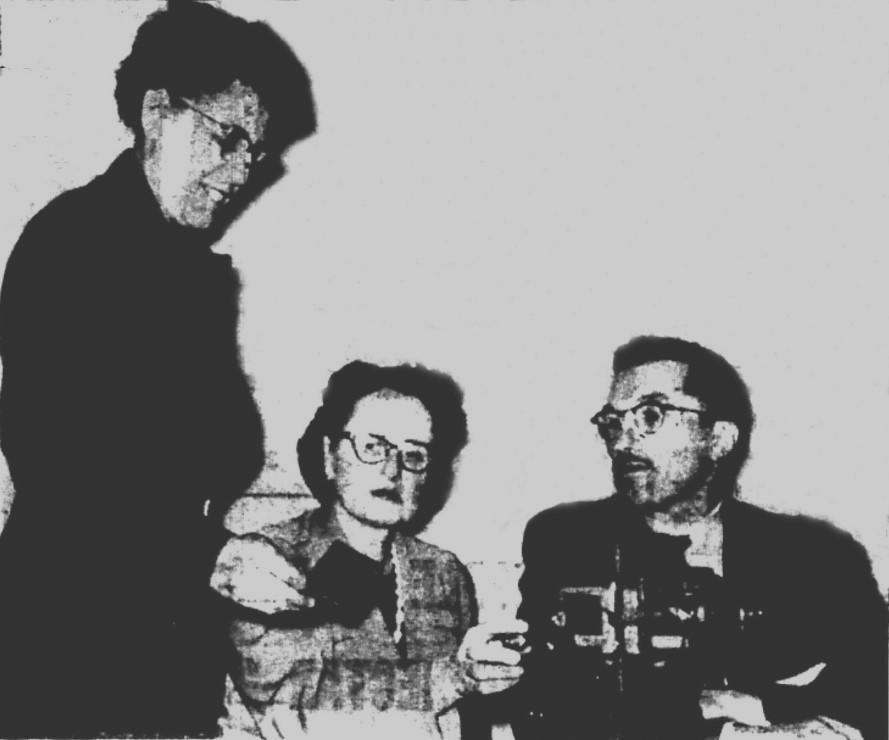
The National Chapter of the YWCA lent the fledgling organization a young woman, Frances Simas, as the first executive secretary. However, by the following year, Miss Simas had married and moved away. Meanwhile, Margaret had been involved in a variety of YWCA programs, including exploring options for a permanent location for the Olympia chapter. The organization settled on the nearby
Kearney house at 220 Union Avenue and fund-raising began in earnest. Margaret helped with the campaign, which resulted in the purchase of the building in 1948. With the departure of Simas, the organization was without an executive director, and it asked Margaret to take the position. Following a month’s orientation on the requirements of running a nonprofit, she became the executive director of the Olympia YWCA. Within one year, the mortgage on the building was ceremoniously burned in 1950, and the organization had over 1,000 users and several activities. An article from that year noted, “Miss Whyte has built up the program of the YWCA beyond all expectations of the organizers here.”13
From that time on, hardly a week went by without some article in the
local newspapers about a program or activity featuring Margaret, whether as director of the YWCA, the presenter of a program, sharing favorite Whyte House recipes, or as president and active member of Zonta. Margaret and Marie were also able to travel, and to return with slides to share with fellow camera club members.14
In 1953, an opportunity came up for Margaret to return to her earlier interest in the needs of senior citizens. Governor Arthur Langlie established a new statewide program called the Governor’s Council for Aging Population. The Council consisted of representatives from various organizations and agencies dealing with the aging. Margaret was asked to take on the job of executive director, officially working under the Department of Public Assistance but with a mandate to serve the entire population of senior citizens, and reporting to the Council.
The Council was established as the United States began to pay attention to demographic and cultural changes taking place in our country. Until the end of World War II, to the extent government entities were thinking at all about the elderly, those individuals were considered a problem to be solved. Social Security benefits did not start flowing in earnest until the early 1940s. Without Medicare and other robust social services in place, the elderly often suffered from precarious health and limited personal wealth. In addition, the development of suburbs
like Levittown on Long Island, New York, and other suburban enclaves, were not conducive to the multigenerational households that had existed in the past. The National Council on Aging was established in 1950 and it grew to encompass state programs throughout the country.15
Margaret and others supported the concept that senior citizens should be considered a community asset rather than a problem to be solved. While recognizing that the needs of seniors did present unique challenges, the Council would also attempt to “raise
Margaret’s photo accompanied a front page article about her selection to head up Council for Aging Population, from the December 7, 1953 Daily Olympian. Photograph courtesy of The Olympian.
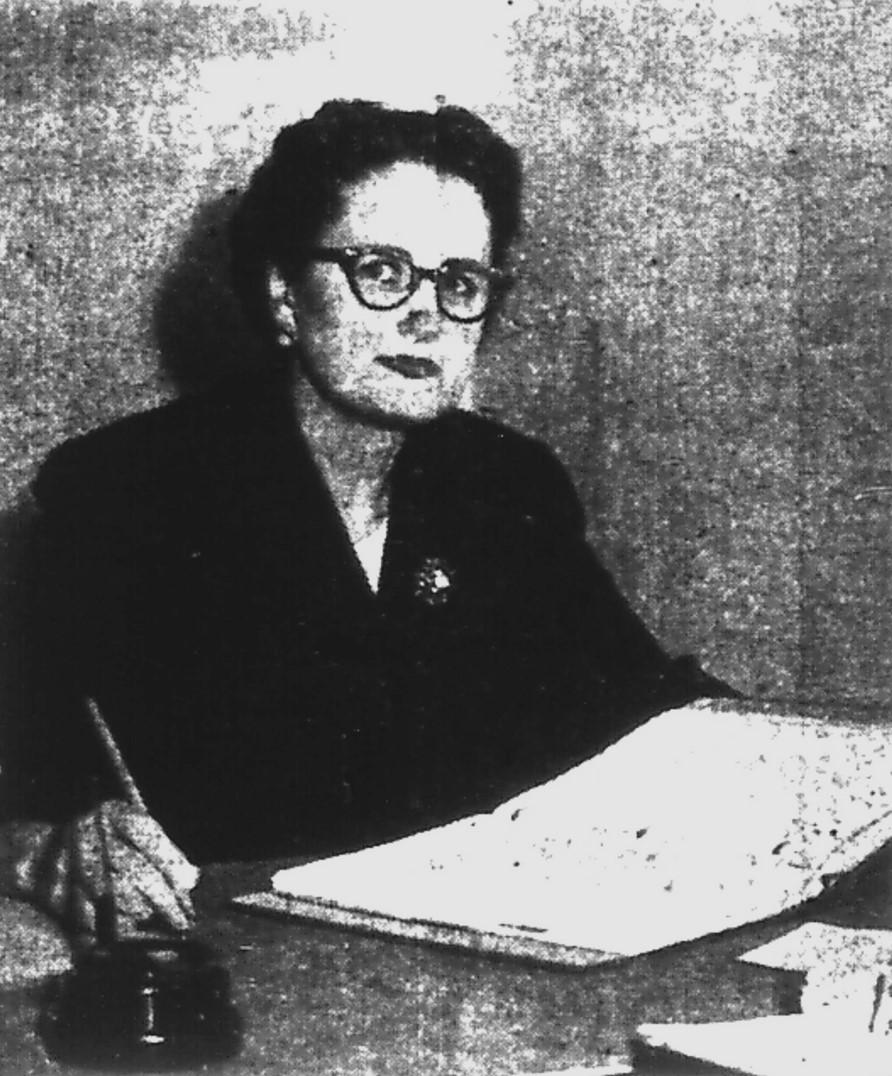
for older people not only the standard of living but also the standard of their human relationships so they may grow old aggressively, creatively and social-mindedly.”16 In other words, Margaret recognized that seniors could be useful, active, happy, contributing members of society.
Margaret launched into her new job with her usual energy and enthusiasm. In March 1954, she outlined a five-part program for improving the lives of seniors:

1. Employment and economic support
2. Education
3. Health and rehabilitation
4. Housing
5. Recreation and leisure time activities17
Governor Langlie agreed: “It is not enough to set up nursing homes,” he said. He wanted “to create an environment in which [seniors] can be happier in the sunset years of their life.”18
A major challenge, however, was the issue of housing for seniors. Until the post-World War II period, housing options were limited. Families could agree to care for their aging relatives, or the more fortunate could hire someone else to do so. Then, there were “old folks homes,” often supported by fraternal organizations or churches, for those without family or finances devoted to their care.19 Nursing homes existed to serve the needs of seniors with health or mobility challenges. And “retirement hotels” existed in urban areas, sometimes
combining features of “old folks homes” and nursing homes. None of these options, though, satisfied Margaret’s desire to create vibrant, involved, creative lives for seniors.
At the same time, seniors were living longer and staying healthier than in the past, in part due to the implementation of Social Security (Medicare was still in the future). So, a growing population was searching for a living environment that would go beyond meeting basic needs. Indeed, in 1958, Margaret attended and presented at a multi-day symposium in Olympia, called “A Place to Live,” dealing with housing issues of all kinds, with her own focus on housing challenges for the seniors for whom she was advocating.20
In a later memoir, Margaret characterized housing as the “greatest unmet need” of seniors.21
Then, in 1960 and 1961, national and local developments coalesced to transform the lives of both Margaret and Marie personally, and senior citizens throughout our region and the nation.
In 1958, Congress had enacted the White House Conference on Aging Act (Public Law 85-908), and the bill was signed by President Dwight D. Eisenhower. The law called for a national citizens’ forum to focus attention on the problems of older Americans and to make consensus policy recommendations on how to enhance the economic security of this demographic group.

In 1960, President Eisenhower announced the first White House Conference on Aging to be held the following year. The original goal of the conference was “to provide a forum for representatives of older Americans throughout the country to discuss
and propose solutions to the unique problems facing the elderly in this country.”22 Now held every decade, the conference has generated ideas and momentum prompting the establishment of key improvements in many of the programs that represent America’s commitment to older Americans including Medicare, Medicaid, Social Security, and the Older Americans Act.23 More than 3,000 people attended the first conference, representing nearly 300 organizations.
Planning for the first conference began in 1960. In preparation, individual states held their own separate meetings with representatives of various industries, to gather information about issues of interest. Margaret attended one such meeting in Seattle in early 1960, specifically focused on housing issues. At that meeting, a man introduced himself to her as Morris Loveless, and indicated that he was considering developing housing for seniors in Thurston County. Margaret, who had been looking for an
opportunity to explore senior housing alternatives, jumped at the chance to collaborate with Loveless (known as Moe), particularly because he was in Thurston County, where Margaret lived and worked.24 Shortly thereafter, she began meeting with him and other potential investors.
Moe Loveless had been developing tract homes between the Mountain View Golf Course and Chambers Lake, in the area which would later become Lacey, Washington. In 1960, the Mountain View Golf Course was in decline. Moe was eying the property for possible expansion and development. One key participant in discussions about the golf course property was a woman named Hazel Post. A somewhat elusive figure, Hazel is described in various Panorama archives as a real estate developer.25 She is often referred to as the first person to bring to Moe the idea of developing the golf course property for senior housing. (Her only mention in the press or Panorama’s contemporary internal documents was as receptionist for the fledgling Panorama City.)
In 1961, Hazel and Margaret both attended the White House Conference on Aging, and came back to Moe with some “novel and interesting” ideas.26
Among the features at the White House Conference on Aging was a groundbreaking installation at 17th and M Street N.W. in downtown Washington, DC. Designed by the
Advertisement for Lakeview Terraces, April 1960 Olympian. Photograph courtesy of The Olympian.
staff of the American Association of Retired Persons (AARP), it was a fullscale home, advertised as the House of Freedom, and built by the Douglas Fir Plywood Association (now APA-The Engineered Wood Association). According to a short biography of its designer, Wallace Ellsworth Difford, the home was built over the course of seven weeks.27 As its name implies, the House of Freedom incorporated elements that would make living safer and more pleasant, and allow seniors to stay in their homes as long as possible. Features included wide corridors to accommodate wheelchairs, grab bars, low windows, no steps, and the like.28 AARP’s founder and first president Ethel Percy Andrus gave President Eisenhower a tour of the home, which received hundreds of visits.

Margaret was one of the many visitors to the home and, as director of Washington State’s Council on Aging, she was invited to send in comments for improvements. Margaret returned to Olympia energized and enthusiastic. She and Marie immediately started planning to build a House of Freedom for themselves, possibly near the ocean, for a future retirement home. They took the House of Freedom floor plan and began making a few modifications suited to the Pacific Northwest. But as Margaret and Marie evaluated their plans, Margaret’s thoughts also came back to Moe Loveless and Hazel Post’s interest in a development targeted specifically toward seniors in Thurston County.
At the time of the 1961 conference, innovations in senior living were developing throughout the country. Sun City and Leisure World were beginning to establish communities throughout the Sunbelt exclusively for seniors, designed for those who were still able and interested in pursuing physical and social activities. Del Webb, the developer of Sun City communities, coined the term “active adult.” Sun City communities were built around a golf course, with surrounding homes for purchase, but few additional amenities. Ross Cortese’s Leisure World communities were similarly targeted, but included many more amenities such as clubs, workshops, and the like. However, neither

of these models incorporated nursing homes or assisted living facilities. In fact, some residents actively opposed incorporating nursing homes into their campuses, believing that they gave the “wrong message.”29
Another model was being developed, primarily on the east coast. This would be a community that would provide independent housing and plenty of activities for active seniors, but also include nursing and transitional facilities as residents aged and needed more care. This model came to be known as the Continuing Care Retirement Community (CCRC), now sometimes known as a Life Plan community. It was this latter model that Margaret and Hazel Post brought back to Moe Loveless and his investors. Moe was enthusiastic. Other investors agreed reluctantly, for at that time there were no CCRCs in the Pacific Northwest. However, Moe began running some numbers and promised investors that the return would be in the millions.30 Panorama City was launched as a division of an umbrella corporation owned by Moe and a few investors. Construction was to begin in early 1962.
Once Hazel and Margaret had made their pitches for a CCRC-based retirement community, development occurred with amazing speed. The first home, completed in 1963, was based on Margaret’s altered House of Freedom design. It was built as a model home just inside the northern en-
trance to Panorama City. It stills exists, with the front of its exterior almost unchanged, although an addition has been built in the rear. Several other Houses of Freedom were built at Panorama City over the next two years.
As Panorama City began to take shape, Margaret and Marie had an epiphany: why not build their own House of Freedom there?
“After studying Panorama City [as it was called then; later the name was changed to just Panorama] for a year, it was decided that Panorama City was the place to come. There was no other place quite like it. I had visited retirement homes in many other places and was so interested in what was going on in Panorama City that we decided that we should move out here. They were glad to use our adjusted plan of the House of Freedom. The one thing that interested us more than anything else was the varying degree of housing and care that was available here. . . . Then we were interested in the continued active life that was encouraged here.”31
Margaret and Marie selected their own home site adjacent to the still-active golf course (occasionally golf balls would hit the home while it was under construction!). Their home featured a fireplace, upon which they insisted, although the original House of Freedom plan did not have one.
Margaret and Marie settled into Panorama City in June 1964. They were
both working, Margaret as head of the State Council on Aging, and Marie in Disability Services. But with her usual energy and enthusiasm, Margaret set out to make the active living aspect of Panorama City a reality. She volunteered to become unpaid Activities Director, and soon an Activities Committee was organized. That committee later became the Resident Council, which is still in existence. Early Resident Council and Activities Committee minutes show Margaret and Marie both involved in several activities, chairing some. Both were interested in the Rockhound Club and displayed their treasures in the annual hobby show (a rockhound is an amateur rock and mineral col-
Top: Early Panorama home. Sprengel Collection, 1965, Panorama Resident Archives.
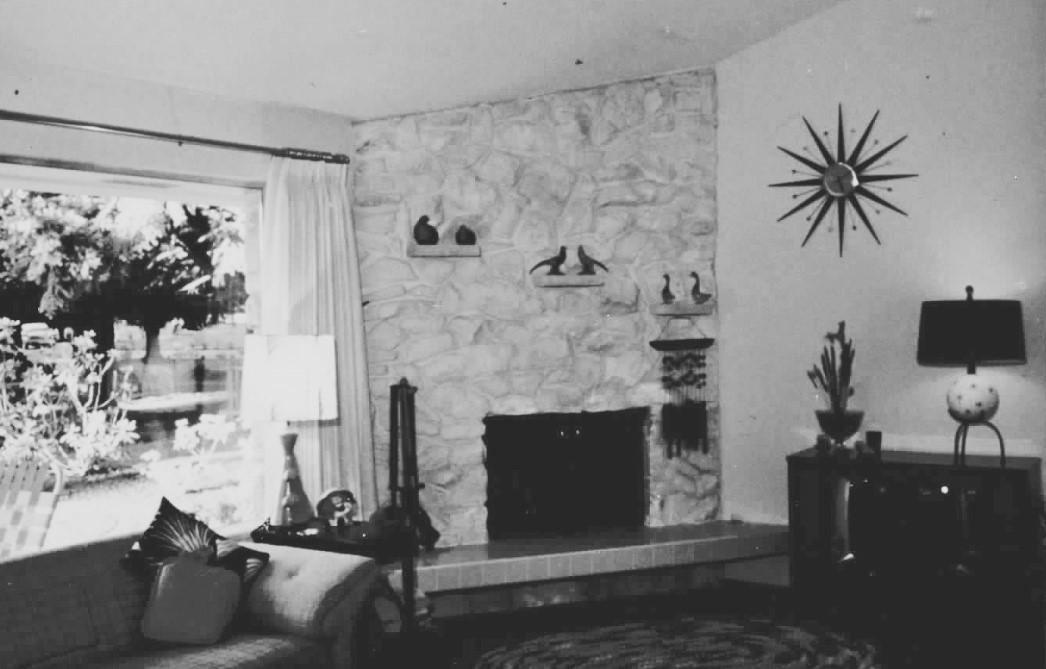
Center: Margaret displays her rockhound talents in an article from the Lacey Leader, July 1971. Photograph courtesy of the Lacey Museum.
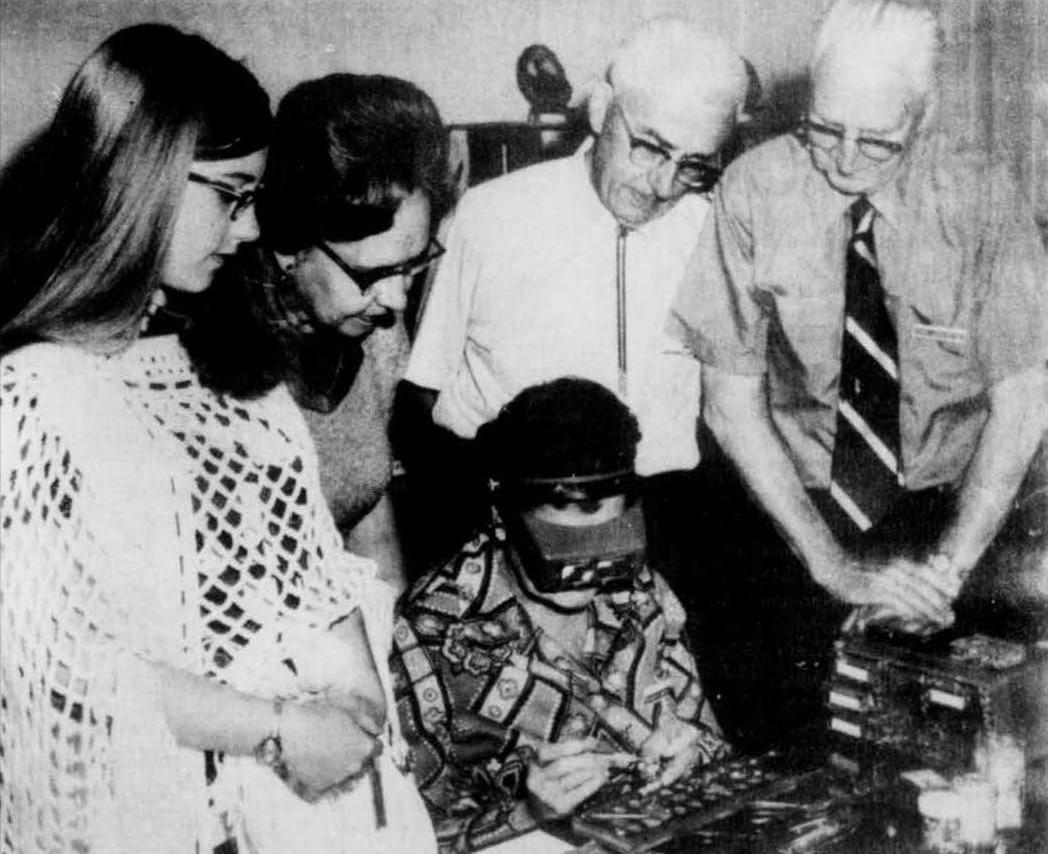
Bottom: Margaret wields one handle of a shovel for the Panorama Hall groundbreaking, fall 1964. Roy McGandy is on the left, and Moe Loveless is on the right. Photograph courtesy of The Panorama City News, FallWinter 1964, Panorama Resident Archives.

lector). Since they were both still working, they participated in the Salt Mine group, consisting of residents who had not yet retired (as in the saying “back to the salt mines”).
Margaret was also involved in Panorama City management decisions. In August 1964, she was selected to participate in groundbreaking for Panorama Hall, the central administrative offices and restaurant, where she wielded one handle of a three-handled shovel. She also served as a trustee for the Panorama Fund, the initial financing mechanism for Panorama City. That fund later evolved into the Panorama Foundation, which now is Panorama’s Office of Philanthropy.32 The program exists to raise funds for activities that enhance resident living, and was responsible for the bulk of fund-raising and financing for the Panorama auditorium.
In 1972, Margaret was instrumental in establishing one of the keystones of Panorama City’s CCRC model, the Benevolent Fund. This fund is supported by contributions from residents and fund-raising activities. It is designed to allow residents to remain in their homes when finances are tight, and funds other programs such as Social Services. Margaret served as an officer of the Fund for twenty years and chaired its finance committee for several of those years.33
Outside of Panorama City, Margaret was active in the First United Methodist Church of Olympia, AARP, and the South Sound Dinner Club, among
other organizations and activities.34 Of note was her service, beginning in 1982, on the Thurston County Committee on Long Term Health Care. That committee was of particular interest to Margaret, even past retirement. She served on Panorama City’s committee on Long Term Health Care and attended conferences and meetings throughout the state addressing this pressing issue. She advocated for better long term care solutions for Panorama City residents as well as seniors throughout the county.35
In 1970, Margaret and Marie retired on the same day. An article in the Daily Olympian observed that they intended to travel to Canada, the Midwest, Hawaii, and Mexico. The article noted that Margaret was now “join [ing] . . . the thousands of persons she has helped in their retirement careers.”36 Upon her retirement, Margaret received a bound volume with hundreds of letters of congratulations and appreciation.
Margaret and Marie remained active at Panorama, with continuing involvement in many activities. Marie died in 1982. Margaret was recognized in her obituary as her survivor, and was named her executor.37 The next year, Margaret was featured in an Olympian advertisement as a twenty-year resident of Panorama.38 One former staff person still remembers her as “an amazing and lovely person.”39 A 1987 article about Margaret in a Panorama City marketing publication includes a photograph of her: she is sitting in a comfortable chair, facing the floor-to-
Left: Margaret Whyte at her retirement. The photo accompanied an article about Whyte in the Sunday Olympian. Photograph courtesy of The Olympian.
Above: Margaret and her home were featured in an article from Panorama Scene, March-April 1987. Photograph courtesy of the Panorama Resident Archives.
ceiling sliding glass doors that were a key feature of her House of Freedom home.40 She noted: “I am still satisfied with the concept of Panorama and still feel Panorama has the best plan.” She continued, modestly, “I think we are very fortunate.”
Margaret continued to live a comfortable, active life for many more years. Eventually she moved into the Quinault apartment building, where she celebrated her 90th birthday in the summer of 1998 (one feature of Panorama’s CCRC model is that residents can downsize when mobility or other issues make independent living challenging).41 She died on January 20, 2003 and was buried in her
hometown in Iowa, about 90 miles from where Marie is interred. Today, few remember her or her contribution to the revolutionary notion, now accepted as fact, that seniors can live active, meaningful, and fun lives and continue to serve their communities.
Equally important was her contribution to development of the Continuing Care Retirement Community model, and to Panorama as a leading example of that model in the Pacific Northwest. When Margaret first met with Moe Loveless and Hazel Post in 1960, there were only four CCRCs in the country, all on the east coast. There are now approximately 1,900.42 Margaret Whyte deserves much credit for
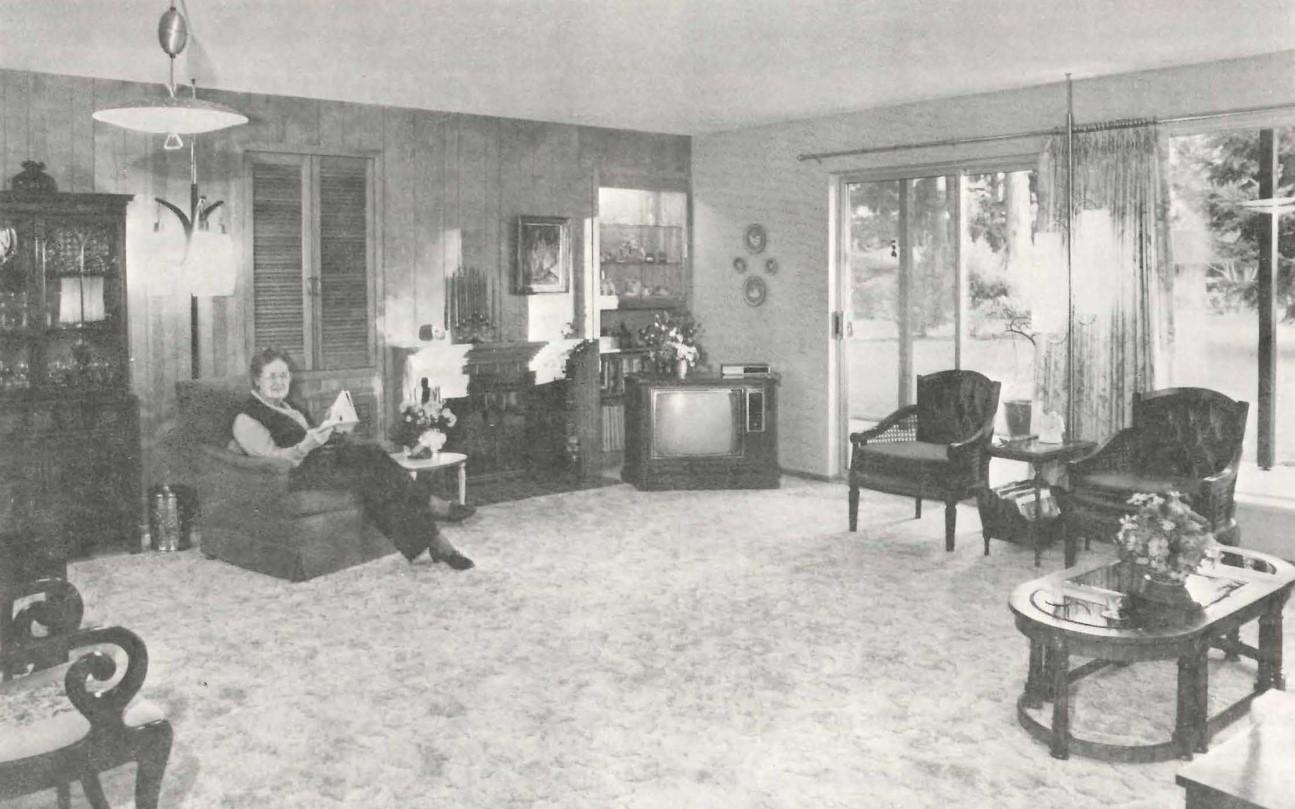
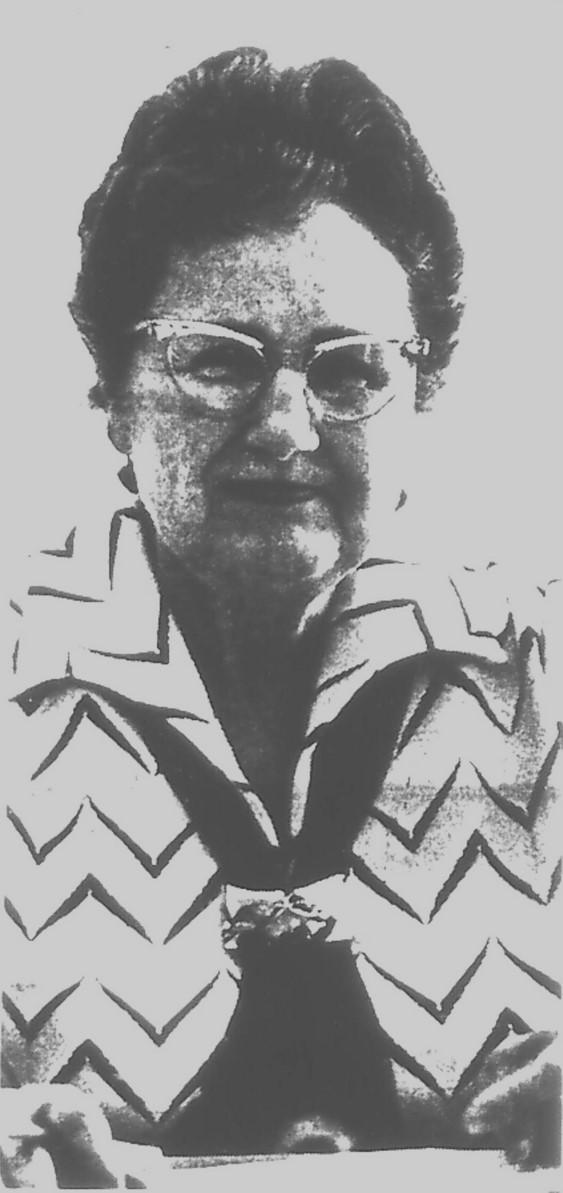
promoting the CCRC model as one option for active senior living. A tribute to Margaret at the dedication of the Margaret Whyte Memorial Garden reads: “Few residents have influenced residents of this community so much as Margaret. In the 1960s as the State’s first director of the Agency on Aging, she promoted the concept of living in retirement” (emphasis in original).43 NOTES
1 Obituary for Margaret Whyte, January 21, 2003, Daily Olympian, posted on Find-A-Grave (https://www.find agrave.com/memorial/150357201/ margaret-faye-whyte, accessed March 31, 2022). United States Census, 1920, Iowa, Wright, Liberty, ED 204 (www.ancestry.com, accessed June 15, 2022).
2 Obituary for Margaret Whyte.
3 “Marie Lemberger and William Lauenroth Wed at Burlington,” Muscatine [Iowa] Journal and News-Tribune, May 31, 1938, page 16.
4 U.S. World War II Bonus Case Files, Iowa, for William M Lauenroth, Ancestry.com (www.ancestry.com/discovery ui-content/view/142024:8825, accessed March 31, 2022).
cialist II, to Karen Johnson, June 14, 2022.
7 Dolores Lauenroth Obituary, 2012, posted on Find-a-Grave (https:// www.findagrave.com/memorial /88187578/dolores-f.-lauenroth, accessed March 31, 2022).
8 Untitled, Daily Olympian, May 2, 1946, page 7. A later handwritten memoir by Margaret says, “I wanted to get out of the Public Assistance field and out of Iowa.” Margaret Whyte handwritten memoir, 1998, Panorama Resident Archives.
9 “Try Her Special Recipes,” Sunday Olympian, December 14, 1952, page 16.
10 “Margaret Whyte to Speak at Special Meeting,” Sunday Olympian, November 30, 1947, page 8.
5 U.S. City Directories, Des Moines, Iowa, 1944, Ancestry.com.
6 Email from Heather Lamp, Des Moines County [Iowa] Judicial Spe-
Margaret Whyte’s gravestone at the Glenwood Cemetery, Goldfield, Iowa. Photograph courtesy of Phyllis Blumer, Find a Grave Memorial 150357201.

11 “Planned Economy,” Daily Olympian, April 6, 1948, page 8.
12 “Expansion By YWCA Proudly Noted Here,” Daily Olympian, May 1, 1950, page 4.
13 “Expansion By YWCA.”
14 “Camera Club to Present Travelogue,” Daily Olympian, March 10, 1955, page 8.
15 National Council on Aging website (https://www.ncoa.org/page/aboutus, accessed March 31, 2022).
16 “Olympia Woman Selected To Help State Study Of Aging Population,” Daily Olympian, December 7, 1953, page 1.
17 “Program For Aging Pushed,” Daily Olympian, March 4, 1954, page 2.
18 “Program For Aging Pushed.”
19 Judith Ann Trolender, From Sun Cities to the Villages: A History of Active Adult, Age-Restricted Communities (Gainesville, Florida: University Press of Florida, 2011), page 39 and following.
20 “Panel Discussion Set For May Fellowship Luncheon Of Council,” Daily Olympian, April 30, 1958, page 10.
21 Margaret Whyte, Early Panorama City History, 1983, Panorama Resident Archives.
(White House Central Files: Staff Member and Office Files) (https:// www.nixonlibrary.gov/finding-aids/ white-house-conference-aging-whitehouse-central-files-staff-member-andoffice-files, accessed June 21, 2022).
23 White House Conference on Aging website, U.S. Department of Health and Human Services (www.white houseconferenceonaging.gov, accessed March 17, 2022).
24 Whyte, Early Panorama City History, page 1.
25 Whyte, Early Panorama City History, page 2. “Dana Kintner’s Story,” Panorama: The First Fifty Years, compiled by Berta Kasmar (Berta Kasmar, 2012), page 26.
26 Kintner, page 26.
27 “Wallace Ellsworth Difford,” World Forestry Organization, https:// www.worldforestry.org/wp-content/ uploads/2016/03/DIFFORD-W.E.. pdf, accessed March 17, 2022).
28 “The House of Freedom,” AARP (https://www.aarp.org/livable-commu nities/housing/info-2018/makingroom-looking-back-the-freedomhouse.html, accessed March 17, 2022). A digital re-creation of the House of Freedom produced by the AARP demonstrates the sixteen features incorporated into the house.
29 Trolender, page 156.
22 White House Conference on Aging
30 Kintner, page 26. The promised millions never materialized and in fact Panorama City never showed a profit. Panorama City became a not-for-profit 501(c)(3) organization in 1983.
31 Whyte, Early Panorama City History, page 3.
32 Whyte, handwritten memoir.
33 Obituary for Margaret Whyte. Benevolent Fund Fund Facts February 2003, Panorama Resident Archives.
34 Obituary for Margaret Whyte.
35 Report by Margaret Whyte to Resident Council, October 1983, Panorama Resident Archives.
36 “Mainly About People,” Sunday Olympian, August 23, 1970, page 5.
37 “On the Record - Obituaries,” The Olympian, February 22, 1982, page 15. Legal Notices, Superior Court filing, The Olympian, March 5, 1982, page C3.
38 Daily Olympian, advertising supplement, December 23, 1983, page Supplement-28 (52).
39 Jeanne Christophersen, email to author.
41 Panorama City News, June 1998, internal publication, Panorama Resident Archives.
42 “How Continuing Care Retirement Communities Work,” AARP, January 22, 2022 (https://www.aarp.org/care giving/basics/info-2017/continuingcare-retirement-communities.html, accessed March 24, 2022).
43 The Panorama Foundation News and Notes, November 2006, internal publication, Panorama Resident Archives.
Deborah Ross is the research coordinator for the Olympia Historical Society and Bigelow House Museum, and the Resident Archivist for the Panorama retirement community. She produces the weekly “Looking Back” feature for the Sunday Olympian and has written two fact-based historical novels based on Thurston County’s Schneider family. She lives at Panorama with her husband Brian Hovis.
40 Panorama Scene, March-April 1987, internal marketing publication, Sprengel Collection, Panorama.
In the April 2021 issue of the Thurston County Historical Journal, Mary Paynton Schaff introduced readers to pioneering lavender grower Luther J. Wyckoff.1 My research assistant discovered Schaff’s article online while researching a coffee-table book I am writing on the 1903 Broadway musical version of The Wizard of Oz.
While I had been unfamiliar with Wyckoff’s years developing lavender, Schaff had been unfamiliar with Wyckoff’s earlier career as an acrobat, actor, and animal impersonator. His most acclaimed role was playing Imogene, the beloved bovine in the littleremembered but hugely influential Wizard of Oz stage musical which ran from 1902 to 1909.2
You might wonder what a cow was doing in The Wizard of Oz. In the earliest stage version, Dorothy’s dog, Toto, became her pet heifer, Imogene.
How Wyckoff came to be a performer in his youth remains a mystery. The 1900 census lists him as “at school,”3 but by June 1902 he was receiving mail as an actor at the offices of The New York Dramatic Mirror.4 Before joining The Wizard of Oz company, Wyckoff was most “recently with the
A candid moment offstage, showing Luther J. Wyckoff (left) relaxing with Arthur Hill, who played the Cowardly Lion. The New York Tribune, September 20, 1903. Photograph from the collection of the author.
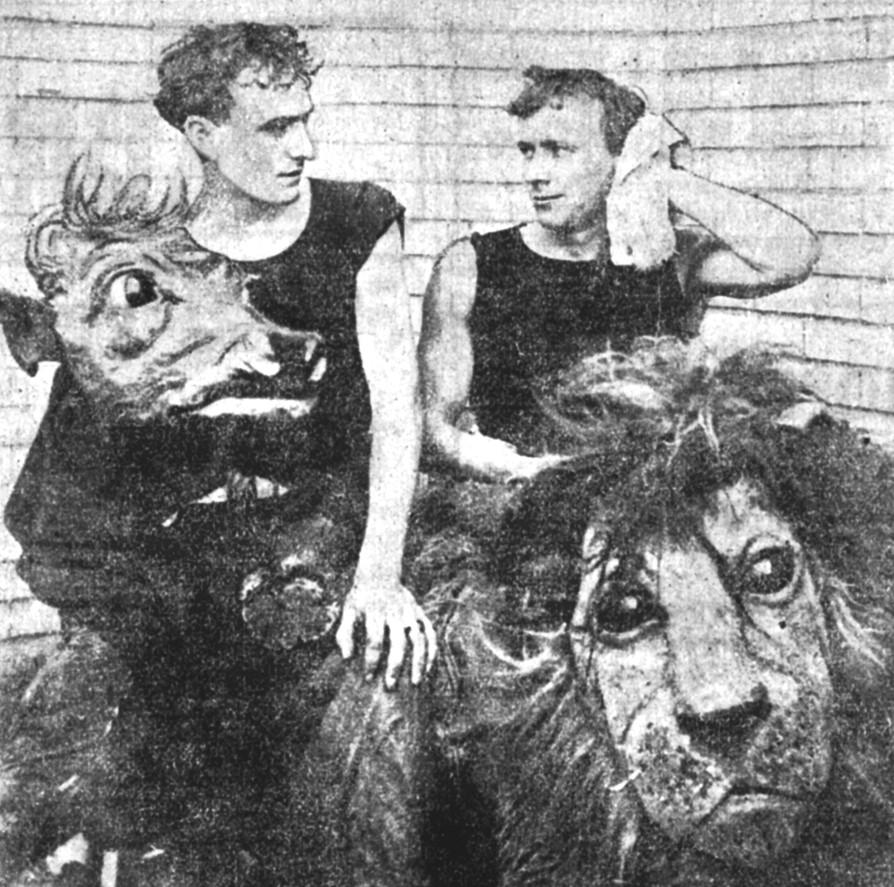
Winter Circus in Berlin.”5
Wyckoff joined The Wizard of Oz company in the fall of 1902 for the pre-Broadway tour, under the name “Charles Wyckoff.”6 He played one of the Wizard’s “Wise Men,” a tiny speaking part but he also sang and danced as a chorus boy. By opening night on Broadway, his credit was on-
ly “Wyckoff,” and he played a “Munchkin Youth.” 7 No doubt Wyckoff’s physical agility and acrobatic stamina landed him his biggest break, understudying the role of Imogene, Dorothy’s pet heifer.
By July 28, 1903, six months into the Broadway run, Wyckoff took over the role.8 “They have a new cow in The Wizard of Oz at the Majestic Theater. The role is apparently an arduous one. Edwin J. Stone had it first,9 but he had to take a rest. Then came Joseph Schrode, and he, too, succumbed. Now Luther Wyckoff, a young German10 acrobat, is trying it.”11
Playing a cow was a grueling task. Bending horizontally, one’s face toward the floor, and holding onto hoofended arm extensions put a great strain on one’s back, making it difficult to breathe in the hot and sweaty costume made of velvet and canvas, with a heavy papier-mâché calf’s head strapped to the top of the performer’s head. The actor operated the cow’s mouth and eyes via wires running from the head down into the beast’s front legs, where they were manipulated by the performer’s fingers.
Wyckoff played Imogene for two weeks, returning the part to Joseph Schrode after Schrode recovered. But Wyckoff had demonstrated his talent as an animal impersonator, and several weeks later the producers rewarded him with the role of Imogene in the second touring company. Wyckoff became the hit of the show.
Wyckoff toured with Company No. 2, as Imogene the cow, for two seasons: from their premiere on September 7, 1903, until May 6, 1905 playing at least 323 cities across the U.S. and Canada. At that time, touring shows disbanded for the summer months and Wyckoff chose to “spend the summer with his brother, Rev. Mr. Wyckoff, in Lincoln [Illinois].”12
Wyckoff began his second season as Imogene on August 11, 1904, in Asbury Park, New Jersey. The company hit the Pacific Northwest in October 1904. The Portland Oregonian13 gave Wyckoff special praise: “Next to the scarecrow the chief source of mirth is ‘Imogene,’ the pet heifer, who follows Dorothy through the show as faithfully as Mary’s historic lamb. Sir Henry Irving may never have to take a back seat for L. J. Wickoff [sic], who does the pantomime stunt inside the skin of the red calf . . . but he extracts more fun from his role of Imogene than a box full of monkeys.”
The Oregon Journal said: “. . . to my notion the cow is the hit of the performance as an instigator of fun.”14
After playing in Portland from October 13-15, the company headed to Seattle for four days. The Seattle Sunday Times said: “A great success was scored by L. J. Wychoff [sic], in the guise of the gentle heifer, Imogene. It was an exceedingly clever achievement.”15 In another review the next day, the critic savaged the cast as a whole but reiterated that “. . . the most clever of all the impersonations
Advertisement for The Wizard of Oz from the Tacoma Daily News, October 21, 1904.

was the Heifer, by L. J. Wyckoff.”16 While in Seattle, Wyckoff almost certainly visited his sister Susan and her husband, Seattle residents.
The company next played Victoria and Vancouver, British Columbia, where, “irrespective of age, everyone was keenly amused by the antics of the drollest cow that ever capered down the pike.”17 The company returned to Washington, and Wyckoff enjoyed a two-day visit with his cousin, J. H. Dunn,18 in Bellingham, where the company played October 24. The company then departed for performances in Everett, Tacoma, Yakima, and Spokane.19 Wyckoff finished the season in May 1905 with performances in Vermont and upstate New York.20
At that point Wyckoff seems to have abandoned his stage career, relocating to Seattle where he had visited relatives the previous summer. Wyckoff found work as a salesman for a variety of products and services.21 But perhaps, too, Wyckoff’s move and change of career was due to meeting his future wife, June Lee McKay. In January 1907, Wyckoff wrote his brother, Rev. W. A. Wyckoff, that he was to be married.22 A newspaper article added, “The benedict [a long-time bachelor] is well-known in Lincoln and is a former actor.”23 The couple married January 16, 1907.24
Here the story of Wyckoff’s life picks up where Schaff’s article begins. Wyckoff must have looked back fondly on his short career as an actor. In August 1918, The Seattle Daily Times reported that Three Tree Point on the Sound between Seattle and Tacoma would present a carnival, including: “twenty ‘colored’ minstrels, . . . a patriotic drill by twenty-five young women . . . . and Luther Wyckoff will recall his ‘Wizard of Oz’ training.”25
Wyckoff’s granddaughter, Emmy Fairfield, remembered “Gran,” as she called him, “deep into farming, . . . quite bald, and shaky from Parkinson’s,” but also recalled her father once telling her that her grandfather had been in The Wizard of Oz. 26
1 Wyckoff was born on December 8, 1881, and died on January 1, 1969.
Mary Schaff, “Luther J. Wyckoff: Growing Lavender on Chambers Prairie,” Thurston County Historical Journal, Number 14, April 2021, page 3.
2 “The Wizard of Oz,” Chicago Daily News, June 17, 1902, page 4. Advertisement, New York Times, April 22, 1909.
3 "United States Census, 1900," database with images, FamilySearch (https://familysearch.org/ark:/61903 /3:1:S3HY-68KS-3XQ?cc=1325221 &wc=9BWW-PT5%3A1030552601% 2C1035480801%2C1035488001 : 5 August 2014, accessed July 13, 2022).
4 “Letter List,” The New York Dramatic Mirror [New York], June 21, 1902, page 20, and June 28, 1902, page 20.
5 “Reflections,” The New York Dramatic Mirror, August 8, 1903, page 7.
6 “The Wizard of Oz” theatre program, Davidson Theatre, Milwaukee, Wisconsin, October 16, 1902.
7 “The Wizard of Oz” theatre program, opening night, Majestic Theatre, New York, New York, January 20, 1903.
8 “Notes of Summer Shows,” The New York Times, July 28, 1903, page 1.
9 “The Wizard of Oz” theatre program, Grand Opera House, Chicago, Illinois, June 16, 1902.
10 Wyckoff was an American of Dutch descent. The Wyckoff Association in
Imogene, the frolicsome heifer, here played by Edwin J. Stone, onstage in the original Broadway production of The Wizard of Oz. Photograph from the collection of the author.
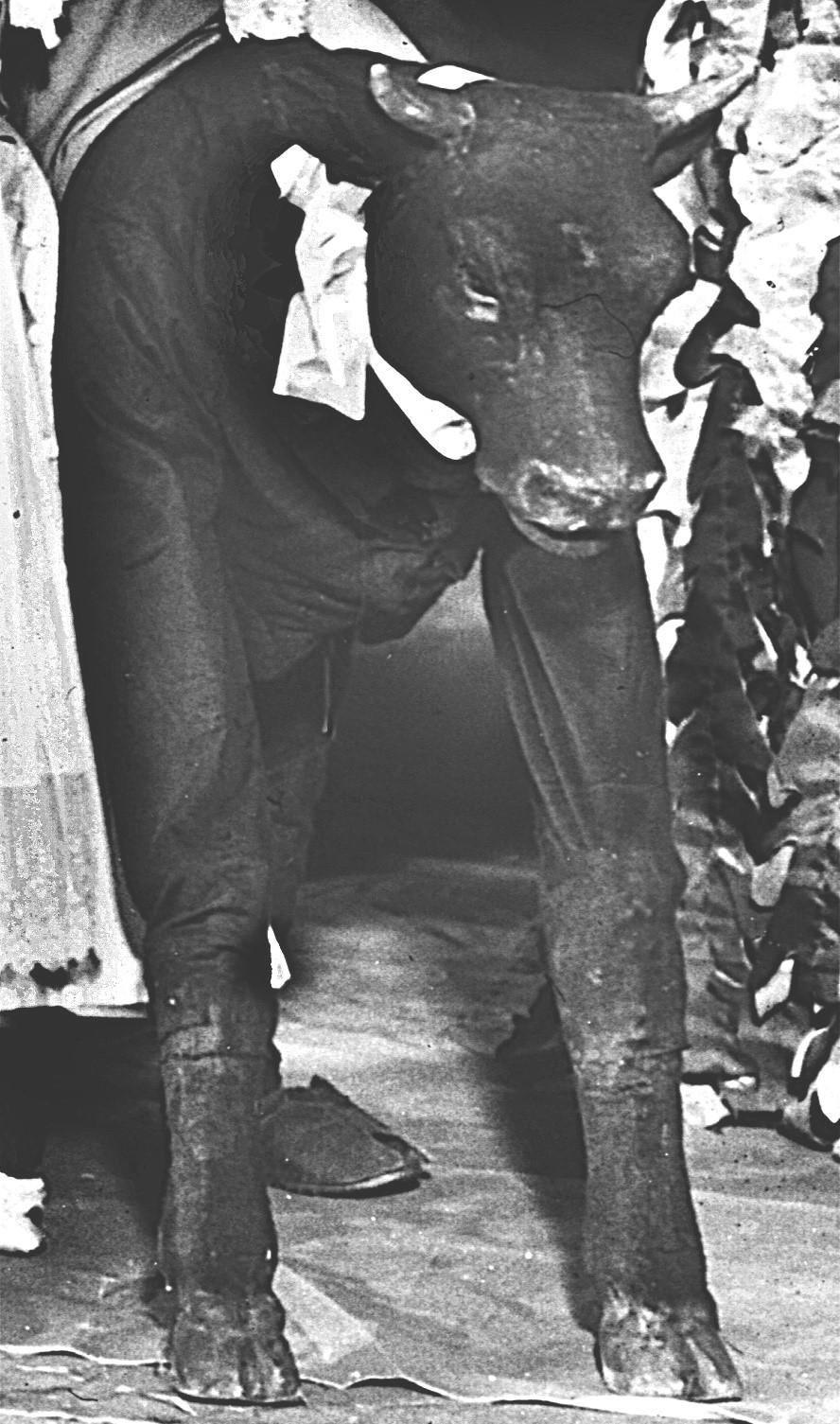
America, Summit, New Jersey, The Wyckoff Family in America, a Genealogy (Rutland, Vermont: The Tuttle Publishing Company, Inc., 1950), page 1.
11 “Stage Notes,” Davenport Democrat [Davenport, Iowa], August 16, 1903.
Edwin J. Stone, the first actor cast in
the part, left the show in April 1903, suffering from exhaustion and tuberculosis. He died August 22, 1903. His replacement, Joseph Schrode, who had assumed the part, was hospitalized with “pulmonary problems” while Wyckoff assumed the role.
12 Weekly Pantagraph [Bloomington, Illinois], June 3, 1904.
13 Oregonian, October 14, 1904, page 9.
14 “At The Theatres,” Oregon Journal, October 14, 1904, page 9.
15 The Seattle Sunday Times, October 16, 1904, page 28.
16 “Extravaganza at the Grand,” The Seattle Daily Times, October 17, 1904, page 7.
17 “The Bovine Imogen, [sic] Scarecrow and Tin Man, and the Lion with the Soulful Eyes,” The Province [Vancouver, British Columbia], October 22, 1904, page 6.
18 “The Wizard Pleases,” Bellingham Herald, October 25, 1904, page 4.
19 History of the Theatre 1901Present, yourhistoriceveretttheatre.org (accessed August 7, 2022). “The Wizard of Oz,” Tacoma Daily News, October 22, 1904, page 18. “The Wizard of Oz is Coming,” Yakima Herald, October 19, 1904. “Come Early or Stand Up,” Evening Chronicle [Spokane], October 27, 1904, page 5.
20 “Wizard of Oz,” Rutland Daily Herald [Rutland, Vermont], May 6, 1905, page 6. “New York,” New York Dramatic Mirror, May 20, 1905, page 7.
21 Schaff, page 4.
22 Daily Illinois State Register [Springfield], January 15, 1907, page 7.
23 Daily Illinois State Register, January 15, 1907, page 7.
24 Marriage record for Luther J. Wyckoff and June Lee McKay, King County Marriage Records, 1855-2017, Washington State Archives, Digital Archives (http://www.digitalarchives .wa.gov/Record/View/1A8FC63 A71A80D55A3A613791F190D35, accessed June 15, 2022).
25 “Society News,” The Seattle Daily Times, August 2, 1918, page 6.
26 Emmy Fairfield letter to the author, February 26, 2022.
David Maxine is a theatre historian and Grammy Award-nominated producer of the two CD set: Vintage Recordings from the 1903 Broadway Musical: The Wizard of Oz, Hungry Tiger Music, 2003. He lives in Portland, Oregon, and is currently completing a coffee-table book on the 1903 Broadway Wizard of Oz musical. You can learn more from his blog, www.Vintage Broadway.com.
World War I reached around the globe in the early 20th Century, affecting millions of people. The conflict extended to homefronts as nations sought to mobilize entire populations in the massive war effort. America was no exception. Many homefront activities in the United States, including those in Thurston County, were organized by the American Red Cross.1
One important Red Cross project in America involved the making of moss surgical dressings for wounded soldiers. These dressings were made and used extensively by many nations during the war.2 Sphagnum (or peat) moss was the plant used. It is an excellent absorbent and has antiseptic properties, making it serviceable for medical purposes. Various species of sphagnum moss are abundant in the Pacific Northwest, including Thurston County, in swamps or bogs. So naturally, gathering moss and creating surgical dressings became part of the County’s homefront efforts. However, this has been forgotten by most regional historians and the public.
During World War I the American Red Cross played a major role on the homefront. Its activities included making both cloth and moss bandages for military wounded. Poster image courtesy of the Library of Congress.
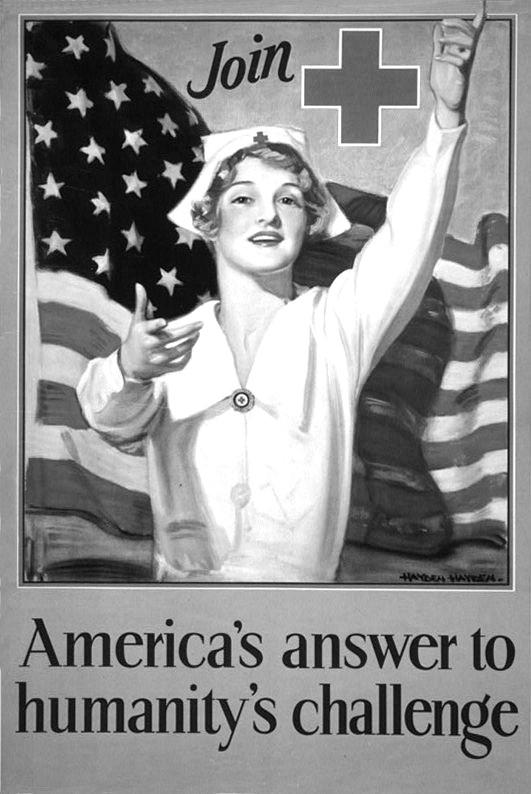
American involvement in World War I began in April 1917 with the declaration of war against Germany and the Austro-Hungarian Empire. Thurston County homefront activities soon started, but it was not until January 1918 that County moss work commenced in Olympia. The Morning Olympian newspaper on January 24, 1918 noted that “the large court room at the Temple of Justice, which has been turned over to the Red Cross, will be used as a collection and preparation room for the moss and the pads which are to be made from it.”3
Several factors at first slowed the moss project. It took time to learn how to make dressings, and shortages in supplies (like gauze) hampered the process. One setback was the tragic death of Harry James Smith in March 1918. This “foremost American authority on the use of sphagnum moss for surgical dressings” died in a collision between an automobile and a train in British Columbia while visiting the Pacific Northwest “to examine the moss and instruct the Red Cross in the new dressings” throughout the region.4 Still the work proceeded and by June 1918, it was in full swing.
Collecting moss was the essential first step in creating the dressings. Peat moss could be found in various places around Thurston County. Johnson Hill, then located a mile east of Olympia (but now within city limits), proved to be one of the best areas for sourcing suitable moss near Olympia.5 Many county residents helped pick the moss.
Sphagnum (or peat) moss proved useful for surgical dressings during World War I. The moss can be found in the Pacific Northwest and around the world. However, this slow-growing moss, living in bogs and fens, needs protection today. It is vulnerable to habitat destruction and chemical pollution. Photograph courtesy of Capitol Land Trust.

Margaret McKenny6 played an important role in local moss collecting during 1918. A Morning Olympian article on March 8, 1918 described her involvement:
“But Miss Margaret [McKenny], who is in charge of the securing of the moss
feels that little could be accomplished in the moss work without the help of her small regiment of boys, and in that she is right. For whenever she so orders, a large seven passenger car, with Miss Evangeline Parker, as a willing chauffeur, is at her entire service and command, with a dozen or so small boys ever ready to clamber in and scout around the swampy woods for the necessary vegetable product.”7
The Elks, a fraternal organization, also actively assisted in Thurston County moss picking. A number of rural Red Cross groups, auxiliaries to the Olympia chapter, collected moss too, including Bush, Fairview, Little Rock, Pleasant Glade and Roadside. The last group even came up with a poem to commemorate their work:
“The following poem, composed by Mrs. T. E. Chambers, inspector for the Roadside Red Cross auxiliary and recited by 11 children of the neighborhood, was an interesting feature of the program given by the auxiliary last Saturday night at the home of Mr. and Mrs. Vernon Peasely, four miles northeast of Olympia:
“Our leader has called us together, And asked if we’d volunteer To gather the moss to make mosspads
And we answered her call with a cheer.
We are all too young to be soldiers, But we want to do what we can. So we’ll gather the moss, clean and dry it, And do ‘our bit’ for Uncle Sam.
“There’s Francis and Abner and Violet, And Nora and Joe and Ike, Adda, Alta and Bertha, All ready to start for a hike. Then away to the cranberry marshes, With Claude and Irene, too; We are going to help ‘Can the Kaiser:’ We are doing ‘our bit.’ Are you?”8
After being collected, the moss needed to be properly prepared. According to a January 24, 1918 Morning Olympian article, “It should be picked thoroughly, all leaves and debris shaken and picked out and it should be squeezed to get the water out as its absorbent qualities are remarkable.”9 Once the plant was ready, volunteers could make the moss dressings or pads.
The process was described in the Washington Standard, an Olympia newspaper, on June 28, 1918: “First there is a layer of special tissue paper, then the moss, then a very thin layer of cotton. The paper is folded over this, a thick layer of cotton added and the whole wrapped in gauze. The ends are then sewed up and the pad ran through an electric wringer.”10
It was hard work. Maud Basey, local head of the Red Cross surgical dressings efforts, stated in June 1918 that, “A skilled worker should make in the neighbor hood of 20 pads a day with all things favorable, . . . That would mean about 500 pads for the month per woman, under the best conditions, which can be scarcely hoped for.”11 Patriotism and compassion for the wounded motivated the volunteers. They were generally supported
by the community, as expressed in the local newspapers.
Furthermore, dedicated workers received special veils (head coverings). These awards were described in the Morning Olympian on August 20, 1918:
“In accordance with directions received from the Red Cross headquarters, recognition is being shown the faithful workers in the dressings de-
partment, by the adoption of colored veils, which signify the hours of service given to the department by the wearers. A blue veil is worn by the manager, Mrs. Basey, who also wears a red cross on the headband, signifying 72 hours service, and one on her apron, signifying 36 hours. Dark red veils are worn by those who have made good as instructors, and have been earned by a dozen or more women.”12
The Temple of Justice in Olympia, seen in this 1916 photograph, was one place in Thurston County where moss surgical dressings were made by Red Cross volunteers during World War I. The building received its stone facing later, by 1920. Photograph courtesy of Washington State Archives, General Subjects Photograph Collection, 1845-2005.
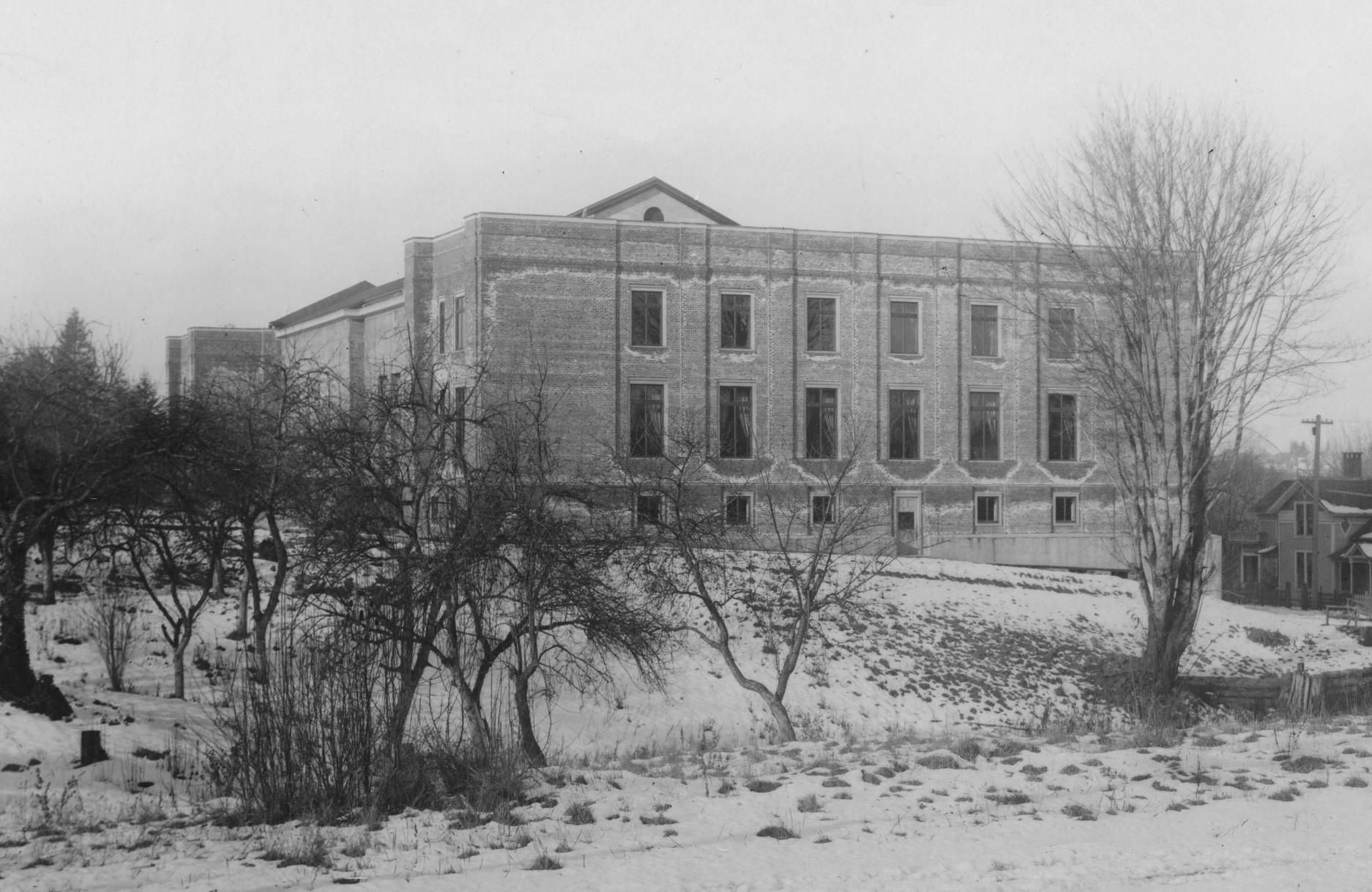
This picture, published in John William Hotson’s 1918 book Sphagnum as Surgical Dressing, shows Red Cross volunteers doing the essential work of sorting moss at the University of Washington before making surgical dressings. There are no known photographs of similar work being done in Olympia. Photograph courtesy of University of Washington Libraries.
Moss bandages became very personal for Red Cross leader Basey. In early August she and her husband Charles heard a report that Captain James D. Basey, their only son, was killed in action in France.13 Fortunately, this report was corrected later in the month. Captain Basey was alive, but seriously wounded.14 It is likely that the army hospital in France, where he stayed and recovered, used moss surgical dressings.
The actual making of moss dressings occurred at several places in Olympia. One was the Reed House, located at 13th and Main (now Capitol Way) streets. Red Cross volunteers used the building to create both moss and cloth surgical bandages. However, when the nearby Olympia High School burned on July 1, 1918, the Reed House was also damaged.15 Red Cross work ceased there. Even before the fire the Reed House had been sold to Millard Lemon and the plan was to move the

building to make room for a developing State Capitol Campus. Indeed, the fire-damaged Reed House was moved in August 1918 to Twelfth and Franklin streets in Olympia.16
Another place for moss work in Olympia was the Temple of Justice on the State Capitol Campus. By this time the building was basically constructed and in use, but the sandstone exterior walls would not be added until 1920. The “moss room” in the Temple saw intensive assembly of moss surgical dressings in 1918 directed by the local
Red Cross chapter. Many volunteers, mostly women, made the bandages. Some did it individually, but others as part of organizations. These groups included Degree of Honor, Helping Hand Circle, Ladies of Woodcraft, Sunset Club, United Churches, and Woman’s Club.
How many moss dressings were created in Thurston County during World War I? The exact total is unknown, but in 1918 the American Red Cross Northwest Division sent its Olympia Chapter several large orders for dress-
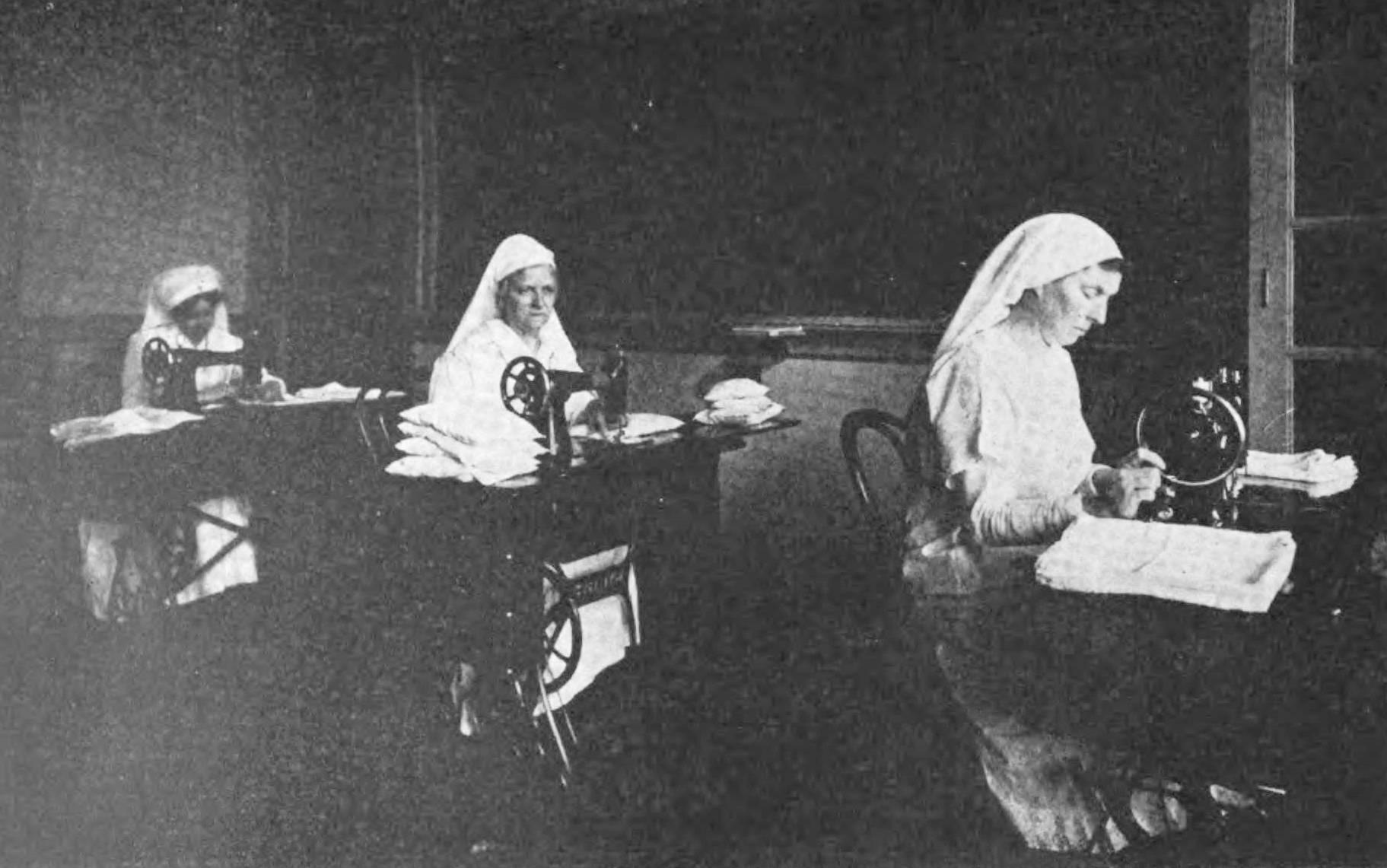
ings. An order for 6,000 pads was received in early June 1918.17 This was successfully completed by mid-July. The Northwest Division then issued an order for 6,000 more dressings.18 Olympia moss workers finished that order and shipped it by September 1. A new, even larger order for 20,000 pads was then expected locally,19 but circumstances changed, as described below, and the order was not filled.
Indeed, the autumn of 1918 saw the end of moss work in Thurston County. In early October the Temple of Justice moss room, among other places where people gathered, temporarily closed due to a local outbreak of the Spanish influenza pandemic.20 Then, when the Temple of Justice reopened in late October, Red Cross efforts switched to the making of gauze flu masks.21 World War I concluded with the Armistice on November 11. The American Red Cross changed their focus to refugee assistance and other post-war tasks.
The assembly of moss dressings was put aside in Thurston County.22 This labor-intensive work passed into history. It had been an aspect of homefront life during World War I that saw nature itself pressed into the effort to help the wounded. Perhaps it should be remembered.
Hope: The Origins of the American Red Cross in Thurston County,” ThurstonTalk, August 11, 2015 (https://www.thurstontalk.com /2015/08/11/american-red-crossolympia/, accessed December 12, 2021). See also Jennifer Crooks, “Thurston County Homefront During World War I,” Thurston County Historical Journal, Number 9, August 2019, pages 12-15.
2 For more general information on the use of moss surgical dressings in World War I, see John W. Hotson, “Sphagnum as a Surgical Dressing,” Journal of the American Peat Society, Vol. XI, No. 4, October 1918, pages 195-226. Natalie N. Riegler, “Sphagnum Moss in World War I: The Making of Surgical Dressings by Volunteers in Toronto, Canada, 19171918,” Canadian Bulletin of Medical History, Vol. 6, Issue 1, Spring 1989, pages 27-43. Peter Ayres, “Wound Dressing in World War I: The Kindly Sphagnum Moss,” Field Bryology, No. 110, November 2013, pages 27-34.
3 “Moss From Bogs Is Used For Surgical Dressings,” Morning Olympian, January 24, 1918, page 1.
1 For more about the Red Cross work in Thurston County during World War I, see Jennifer Crooks, “Beacon of
4 Louise Ayer, “Red Cross Activities,” Washington Standard [Olympia], March 29, 1918, page 8. This article also stated that Smith “had been a successful playwright and author, and like so many others, had laid aside all his personal interests and enlisted in the Red Cross. His loss is a great one to the country, but he had done his work for the northwest division and
we shall soon begin to profit by it.”
5 “Forest Is Removed From Johnson Hill,” Morning Olympian, February 9, 1918, page 1. “Boys Go After Moss Near Shaffersville,” Morning Olympian, May 1, 1918, page 4.
6 Margaret McKenny (1885-1969) later became a “widely-known Olympia author, conservationist and an acclaimed authority on mushrooms” (“Death Claims Miss McKenny,” Daily Olympian, August 5, 1969, page 1). She helped preserve Olympia’s Sylvester Park and Watershed Park as well as the Nisqually Delta. See “The Spirit of Margaret McKenny: Loving the Natural World,” Thurston County Historical Journal, No. 10, December 2019.
7 “Women Preparing Moss For Use in Hospitals While Men Aid Kiddies,” Morning Olympian, March 8, 1918, page 1.
8 “Poem Tells Of War Work By Children,” Washington Standard, August 16, 1918, page 8.
9 “Moss From Bogs.”
10 Louise Ayer, “Red Cross Activities,” Washington Standard, June 28, 1918, page 6.
11 “Red Cross Workers Have Big Pad Task,” Morning Olympian, June 5, 1918, page 1.
12 “Expect To Finish Moss Pads By September,” Morning Olympian, Au-
gust 20, 1918, page 1.
13 “Son Of Olympian Worker In Red Cross Killed In Action,” Morning Olympian, August 3, 1918, page 1.
14 “Capt. Basey Hurt In Battle But Will Recover,” Morning Olympian, August 20, 1918, page 1.
15 Jennifer Crooks, “July 1918: Olympia High School Burns Down,” ThurstonTalk, July 22, 2018 (http:// www.thurstontalk.com/2018/07/22/ olympia-high-school-burns-down-july1918/, accessed August 19, 2018). Though commonly known as Olympia High School, the school was officially William Winlock Miller High School. This situation is still true for the current high school on North Street.
16 “Move Reed Home,” Morning Olympian, August 9, 1918, page 4.
17 “Red Cross Workers Have Big Pad Task.”
18 “6,000 Moss Pads New Quota Of Red Cross,” Morning Olympian, July 14, 1918, page 1.
19 Louise Ayer, “Red Cross Activities,” Washington Standard, October 25, 1918, page 4.
20 “Red Cross To Put Off Work,” Morning Olympian, October 9, 1918, page 4.
21 “Olympians Adopt Flu Masks To Foil Germs,” Morning Olympian, October 29, 1918, pages 1 and 4. “Red Cross
Wants More Women To Make Masks,” Morning Olympian, October 29, 1918, page 1. Louise Ayer, “Red Cross Activities,” Washington Standard, November 1, 1918, page 8. Louise Ayer, “Red Cross Activities,” Washington Standard, November 8, 1918, page 8.

22 Louise Ayer, “Red Cross Activities,” Washington Standard, November 15, 1918, page 7.
Drew W. Crooks graduated with a bachelor’s degree in history and anthropology and a master’s degree in museology (museum studies) from the University of Washington. For over 30 years he has worked with museums in the South Puget Sound region, written articles and books on area heritage, and presented history talks to school classes and community groups.
You would think a state symbol might be a fairly durable thing adopted once and for all time. That might be true with some symbols, such as a state tree or bird not so with state songs. Washington has had a plethora of contenders over the last century.
FIRST UPThe first official state song was written with no pretensions of being a state anthem. After a few false starts, University of Washington students finally published a book of varsity songs in 1909.1 Among other submissions was a poem titled “Washington Beloved,” penned by Edmond Meany, a history professor at the University. The verses were favorably received, and Meany approached well-known composer Reginald De Koven to set the poem to music. De Koven agreed and subsequently submitted a tune for which he was paid the munificent sum of $100 (about $3,100 in today’s economy; perhaps not outrageous considering he also wrote the music to the old standard “Oh Promise Me”).2
Although Meany’s poem was originally meant as a college song (and in later years was re-published under the title “Loyal and True,”3 encouraging allegiance to the old alma mater), somewhere along the musical line, the tune

was proposed as our state anthem.
Some sources claim that this tune was never officially adopted as the state song. Yet legislative records show it as being approved on March
18, 1909, by concurrent resolution and not as a law.4 One verse went:
“Thy name, O Washington renowned, We hail, we hail from far and near, Thy glories joyfully resound, In song of praise and mighty cheer.”
In the mid-1920s, the Washington State Federation of Women’s Clubs organized a contest to find and adopt an official song for their group. The prize went to a tune titled “O Washington,” with lyrics by Glenn Hughes5 and music by Helen Hastings Rankin.6 There is no evidence that this song ever gained any traction as an official Washington state song, although it might have made a good one. Lyrics included:
“Where thy lofty mountains rise High o’er plain and sea, Here we proudly lift our eyes, Filled with love of thee.
O Washington, O Washington! The fairest state beneath the sun! Our hearts shall fill with rapture’s thrill
Till time be done. O Washington!”7
In 1939, well-known songwriter Al Hoffman’s “It’s A Hundred to One You’re From Washington” was touted on national radio programs as our new state song. Although the Lewiston Tribune reported that the “music, fast and catchy, puts a swing to the piece,”8 I challenge you to find a rendition on YouTube. And again, no evidence suggests this tune was ever officially considered as a state song. It was, however,
adopted for our state’s Golden Jubilee celebration.9
“If you rave about friends that are truer, Boast about skies that are bluer, It’s a hundred to one you’re from Washington, A native of the great Northwest.”10
Other hopefuls included “My Washington” (1913) and “The Dear Old State of Washington” (1948).11 Still more songs with Washington in their

titles likely started out as college fight songs, either for the University of Washington or Washington State College (later University).
And now we come to the officially official Washington State Song, “Washington, My Home.” Many of us learned this one in school. The music and lyrics were composed by Helen Davis of South Bend. Davis was apparently a force of nature in her town: realtor, mother, church pianist, and insurance agent who helped procure Pacific County’s first x-ray machine and aided in establishing that county’s health department.12 She originally titled her song’s lyrics “America, My Home” but rewrote the words around 1950 for a local celebration. Representative Joe Chytil of Chehalis fell for it, played it repeatedly on his radio station KELA, and then shopped the idea of making it a state song to his fellow legislator, Senator Bob Bailey. The melody sailed through the House and Senate, and in 1959 was formally adopted as our state song.13 So it has remained ever since.
The City of South Bend and the Willapa River Lions dedicated a park on the Willapa River to Helen Davis, composer of “Washington, My Home.” Photograph courtesy of Brian McCormack via www.google.com/maps.

tos said. State Attorney General John J. O’Connell cleared up the matter, and legal ownership of Helen Davis’s version was obtained for the state.14
Shortly after its adoption, Vincent W. Bartos of Wenatchee claimed he had written and copyrighted a song also titled “Washington, My Home” but with different lyrics and music. “I don’t want to cause any trouble, but I thought people ought to know,” Bar-
Davis’s song met with mixed reviews; today’s youth likely think it is too stodgy, if they are familiar with it at all. The Seattle Times commented on the adoption of “Washington, My Home”: “It’s hard to tell what makes a
song ‘catch on’ with the public. But one thing is certain: It can’t be done by legislation.”15
In 1985, jazz musician and Tumwater tavern owner Thomas “Red” Kelly wrote lyrics and music for “Our State of Washington,” a short paean to our corner of the Northwest. Kelly was much better known, however, for creating the OWL party (Out With Logic, On With Lunacy) in 1976; he ran unsuccessfully for governor that year, garnering only eight percent of the vote, but nearly one hundred percent of the laughs (one of his campaign slogans was “Unemployment Is Not Working”).16
“The crown of the nation above all the rest, Pride of the people who reside in the West, A voice for the future where each has a part, Our state of Washington, A state of the heart.”17
Also in 1985, songwriter Dana Lyons from Seattle was moved to pen an environmental protest song titled “Our State is a Dumpsite.” At rallies around the state, Lyons was joined by sponsors Greenpeace and the Washington Public Interest Research Group in promoting his tune as a new state song.18 At that time, the Hanford Nuclear Reservation in eastern Washington was poised to become the first underground burial site for high-level nuclear waste from across the coun-
try. Lyons’ not-so-tongue-in-cheek lyrics bemoaned the possible outcome:
“I lost my job here fishin’ And opened up a store, I buy and sell reactors, Cooling towers and lead doors. We’ve got a whole new industry Bearing fruit of a finer taste. We sell juice to California And get paid to keep the waste.”19
About the same time came the grassroots fervor of “Louie, Louie.” The song was written as a rhythm and blues number in 1955 by Los Angeles musician and songwriter Richard Berry, but was popularized as a rock version by The Wailers and The Kingsmen a few years later.20 The song has been covered by many singers and bands since, including Paul Revere & the

A “Louie Louie” button helped promote a movement to make the tune our state song. Image courtesy of Louie Louie Web (https://louielouieweb.tripod.com/default.htm).

Raiders, the Beach Boys, Otis Redding, The Angels, the Kinks, the Sandpipers, and even the Grateful Dead and Bruce Springsteen.
The lyrics had absolutely nothing to do with Washington, yet this song probably came closer than any other to replacing “Washington, My Home” as our official tune. Originally intended as a sailor’s ode to his girlfriend, the lyrics morphed into a nearly unintelligible jumble variously interpreted by different singers. Rumors started, as rumors will do, from no discernable source, and the rumors claimed that the lyrics were obscene. A thirtymonth-long (!) FBI investigation (these were the ’60s, after all) failed to draw any conclusions, because agents were “unable to interpret any of the wording in the record.”21 All of this hullabaloo of course did nothing but push the song up the charts. Since then, the song has enjoyed continued popu-
larity, regardless of its lyrical interpretation.
In 1985, original composer Richard Berry penned new lyrics specific to our state:
“I get a call from Washington, To the Northwest I must come, To sing the song everybody knows, Louie, Louie, me gotta go.
Through the snow and through the rain,
The days are short, the nights are long, Hurry train, to Washington.
“The Wailers, and the Kingsmen, too, We all on stage to get a groove, All the people sing along, I never leave Washington.”22
In March 1985, a resolution was pre-
sented to the Washington State Senate, asking that April 12, 1985 be officially designated as “Louie Louie Day.”23 The resolution passed. The following year, Senate Bill 5024 was introduced asking that “Louie Louie,” with the new lyrics, be adopted as Washington’s official rock-n-roll song. That resolution failed. But the song continues to be our officially unofficial rock number.24 As recently as 2003, then-Governor Gary Locke proclaimed August 24 to be “Louie Louie Day” statewide.
And what did Helen Davis, composer of our real state song, think of all this? In a 1985 interview, she “diplomatically acknowledged that ‘Louie Louie’ probably has a time and a place. . . . But ‘Great Scott!’ she scoffs, ‘it’s not a state song’. . . . She plans to take time to learn how to play ‘Louie Louie.’ ‘I want to know what my competition is all about,’ she said.”25
During the hubbub over “Louie, Louie,” another replacement was proposed: “Roll On Columbia, Roll On,” a folk song written by the incomparable Woody Guthrie.26 Guthrie’s son, Arlo (also a singer/songwriter), rallied for the cause, but this effort failed, too.27 However, in 1987, the legislature passed a bill making Guthrie’s tune the state’s official folk song.28
Down her wild mountains and canyons she flew Canadian Northwest to the oceans so blue
And what about the 2011 initiative to replace “Washington, My Home” with “Not In Our House” by Sir-Mix-A-Lot? Fortunately (depending on your point of view), this initiative never made it to an election ballot.
No doubt other songs will be proposed in the future. If I had my pick, I might vote for “The Old Settler” written by Thurston County resident Francis Henry way back in 1874 and made popular by Seattle restaurateur and folksinger Ivar Haglund, who retitled it “Acres of Clams.” For that story, please see “The Old Settler” by Drew Crooks in the December 2019 issue of the Thurston County Historical Journal.
Me gotta go now.
The Kingsmen popularized a raucous version of “Louie, Louie” in 1963. Photograph in public domain, created by Scandore/Shayne.

1 “State University Issues Song Book,” Seattle Daily Times, May 19, 1909, page 9.
2 Harry C. Bauer, “Requiem for an Anthem,” The Pacific Northwest Quarterly, Vol. 51, No. 2, April 1960, pages 80-85.
3 Bauer.
4 “Officially, It’s Your Song,” Seattle Times, November 27, 1959, page 8.
5 Hughes was the director of the University of Washington’s drama program for over 30 years, and pioneered the “theater in the round” concept. He also gained some fame as a poet. Cassandra Tate, “Hughes, Glenn (18941964),” (www.historylink.org/File/ 3694, accessed May 18, 2022).
6 Rankin was a well-known pianist in Seattle, and an active member of that city’s Ladies’ Musical Club. The Washington State Federation of Women’s Clubs held a contest in which 57 entries contended for the music to Hughes’ lyrics. “Official Song Contest Has Closed,” Seattle Daily Times, May 8, 1925, page 18. “Woman’s Century Club at Corner Stone Ceremony,” Seattle Daily Times, August 1, 1925, page 9.
7 “Poem of Club to Feature Session,” Seattle Daily Times, March 8, 1925, page 46.
Woody Guthrie wrote a collection of 26 songs during his month-long employment with the Bonneville Power Administration. Image in public domain.

8 “Washington To Sing New Song During Jubilee,” Lewiston [Idaho] Tribune, January 9, 1939, page 2.
9 “Legislature to Inaugurate State’s Jubilee Fete,” Seattle Sunday Times, February 19, 1939, page 10.
10 “It’s a Hundred to One You’re from Washington,” Coulee City Dispatch, January 12, 1939, page 2. Hoffman also wrote “Auf Wiedersehen, My Dear,” popularized by Russ Columbo, Bing Crosby, and others. “Auf Wiederseh’n, My Dear” (Russ Columbo, 1932) (www.youtube.com/watch?v=m
GALZUIVYAI, accessed May 25, 2022). “His ‘Mairzy Doats’ was a national craze,” Songwriters Hall of Fame (www.songhall.org/profile/Al_Hoff man, accessed May 25, 2022).
11 “My Washington” by Harry L. Stone, Oregon Digital Historic Sheet Music Collection (https://oregondigital.org/ sets/sheetmusic, accessed May 26, 2022). “The Dear Old State of Washington” by Flora I. Behmer, Catalog of Copyright Entries, Third Series, Published Music (Washington D.C.: The Library of Congress, January-June 1948), page 22.
12 Peyton Whitely, “Helen Davis, Who Wrote State Song and Was Matriarch of South Bend,” The Seattle Times, January 2, 1993 (archive.seattletimes. com/archive/?date=19930102&slug =1677850, accessed May 25, 2022).
13 “State Song – ‘Washington, My Home’ ,” Washington Secretary of State (https://www.sos.wa.gov/seal/ symbols_songs.aspx, accessed May 19, 2022). Revised Code of Washington, Title 1, Chapter 20, Section 070 (eReference Desk, www.ereference desk.com, accessed May 19, 2022). An interesting jazz version by The General’s Seven Dixie Band may be heard at https://www.youtube.com/watch? v=pvfEE5SHT1s.
14 “New State Song May Hit Sour Note,” Seattle Post-Intelligencer, June 21, 1959, page 2. “State Legally Owns Official Song Now,” Seattle PostIntelligencer, August 25, 1959, page 1.
15 “Officially, It’s Your Song.”
16 “Red Kelly, Seattle-area bandleader and gag politician, dead at 76,” Seattle Times, June 10, 2004 (https:// archive.seattletimes.com/archive/? date=20040610&slug=webredkelly10, accessed July 18, 2022).
17 Linda Allen, Washington Songs and Lore (Spokane: Melior Publications, 1988), pages 131, 146-148.
18 Allen, page 118.
19 Dana Lyons, “Our State is a Dumpsite,” https://cowswith guns.com (accessed May 18, 2022). “N -repository foes take protest on the road,” The Oregonian, October 24, 1986, page 70. “Humor drives home anti-nuclear dump message,” The Oregonian, October 31, 1985, page 103.
20 “The Story Behind Louie Louie,” Great Oldies, February 2, 2022 (https://greatoldies.com/louie-louie/, accessed May 9, 2022).
21 David Mikkelson, “Are the Lyrics to ‘Louie, Louie’ Obscene?” (www. snopes.com, accessed May 9, 2022).
Peter Blecha, “Louie Louie—the Saga of a Pacific Northwest Hit Song” ( www.historylink.org/ File/5206, accessed May 9, 2022).
22 The Louie Louie Lyrics (https:// louielouieweb.tripod.com/lyrics.htm, accessed May 9, 2022).
23 Floor Resolution 37, Floor Recordings, March 15, 1985, Senate, Office
of the Secretary of Senate, Floor Recordings, 1971-2017, Washington State Archives, Digital Archives (http://digitalarchives.wa.gov, accessed May 9, 2022).
24 “The Campaign to Make Louie Louie the State Song of Washington” ( https://louielouieweb. tripod.com/state_song.htm, accessed May 9, 2022).
25 “State anthem’s author: 60s tune can’t compare with her imagery,” Democrat-Herald [Albany, Oregon], March 13, 1985, page 7.
26 Woody Guthrie was part of New York’s radio and entertainment world, but decamped to the Northwest in the early 1940s. He was hired by the Bonneville Power Administration to
write a collection of tunes titled “Columbia River Songs,” of which “Roll On, Columbia” was one. “Woody Guthrie’s Biography” (www.woody guthrie.org/biography/biography 5.htm, accessed May 26, 2022).
27 T. R. Reid, “States wrangle over song,” Las Vegas Review-Journal, June 2, 1985, page 6C.
28 Allen, page 130.
Karen L. Johnson has worked in the museum field since 2001. She has written many history articles and coauthored two books about a Washington pioneer. She currently serves as the curator at the Olympia Tumwater Foundation, and as the editor of the Thurston County Historical Journal.
A tattered placemat from Ivar’s Acres of Clams restaurant quotes “The Old Settler” poem written by Francis Henry. Image courtesy of Drew W. Crooks.
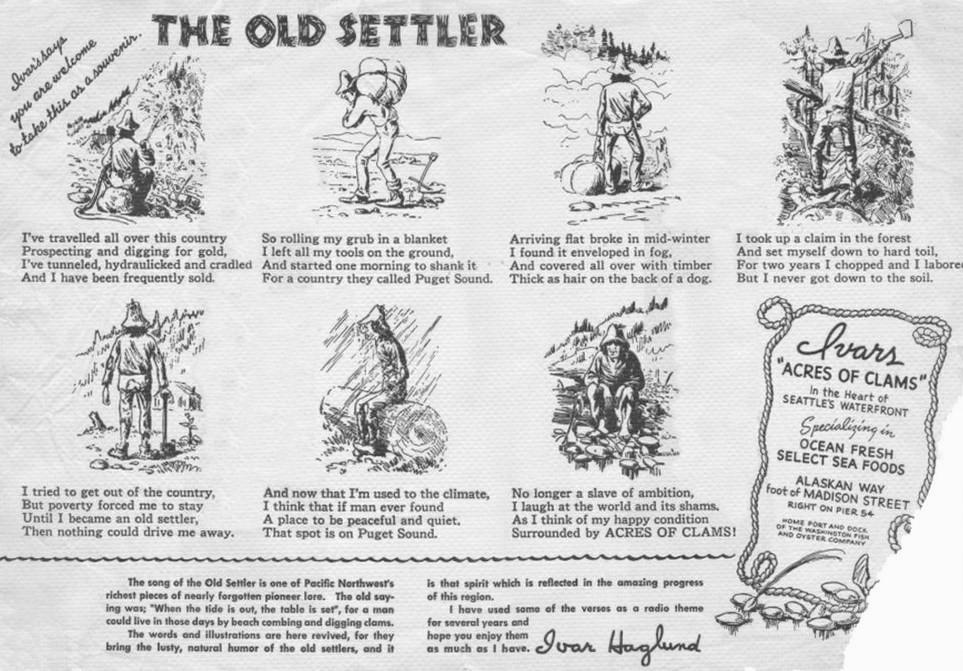
This image of ruins was made in 2015 by Mike Mander at the site of the former mill town of Bordeaux. Located southwest of Littlerock, Washington, that community was located just inside the southeast edge of the Black Hills. The area is now within the bounds of the Capitol State Forest. During the first four decades of the 20th Century, the Mason County Logging Company had its Thurston County headquarters here. An auxiliary unit of the logging company, the Mumby Lumber and Shingle Company, operated a sawmill, shingle mill, planing mill, and a box factory at Bordeaux.
The ruins visible here are remnants of the powerhouse that supplied the energy needed to run various machinery at Bordeaux. Almost no other structures at Bordeaux still exist. The area is currently closed to visitors. Permission to publish this photograph was given by Mike Mander. His entire Bordeaux portfolio can be accessed online at: http:// www.mikemander.com/2015/06/gallery -ruins-of-bordeaux-wa.html.
Author Jim Hannum will discuss the history of Bordeaux and the Mason County Logging Company in a future
